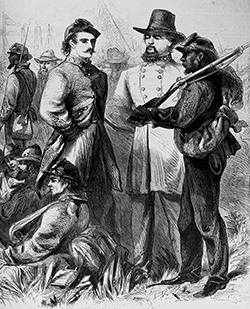
Please send all Checks and Money orders to :
Dave Taylor P.O. Box 87 Sylvania, OH 43560
419-842-1863
Click Here to E-mail Us!
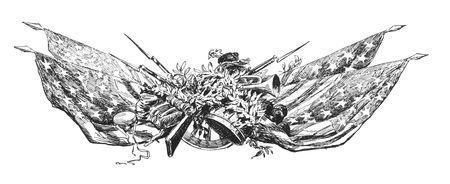

13 10
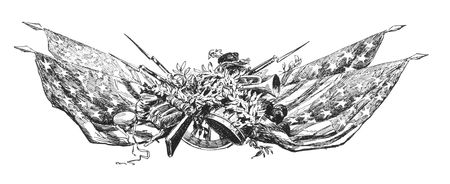
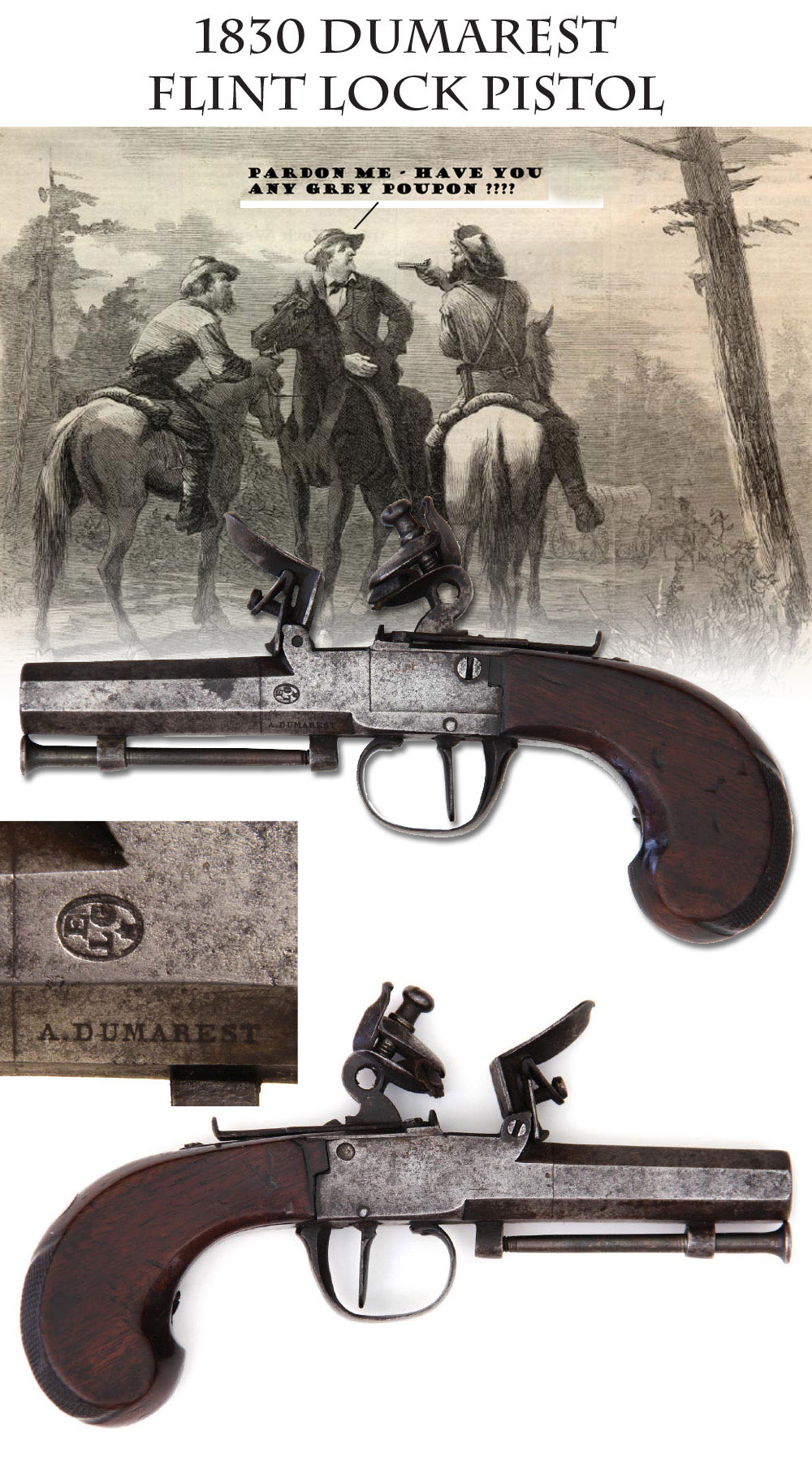
13-10-01 … Beautiful French-Belgian flintlock screwbarrel pistol by A. Dumarest …
A fine belt or pocket size pistol of roughly 50 caliber measuring seven inches overall and having a 2.25 inch octagon barrel. Bottom mounted ram rod passes through the forward thimble and then threads securely into the rear thimble to prevent loss. Not as fancy as some European guns, but a great every-man’s pistol from the first part of the 19th century. Dumarest guns are known signed Paris and St. Etienne, and some are so signed while also bearing the Belgian “ELG” Liege proof mark. This gun’s signature does not include a French city so may be strictly Liege made. There are at least two French makers with this surname. Walnut stock has a checkered pattern on the back, and a small silver escutcheon on the wrist. Barrel bears Belgian proof marking and the maker’s stamp “A. Dumarest”. I hope you will indulge my whim of referencing the old mustard commercial in the caption in our clip art. 100% original 100% complete and mechanically perfect. Ca 1830
… $695.00 SOLD
Click Here to E-mail Us!
Call us @ 419-842-1863
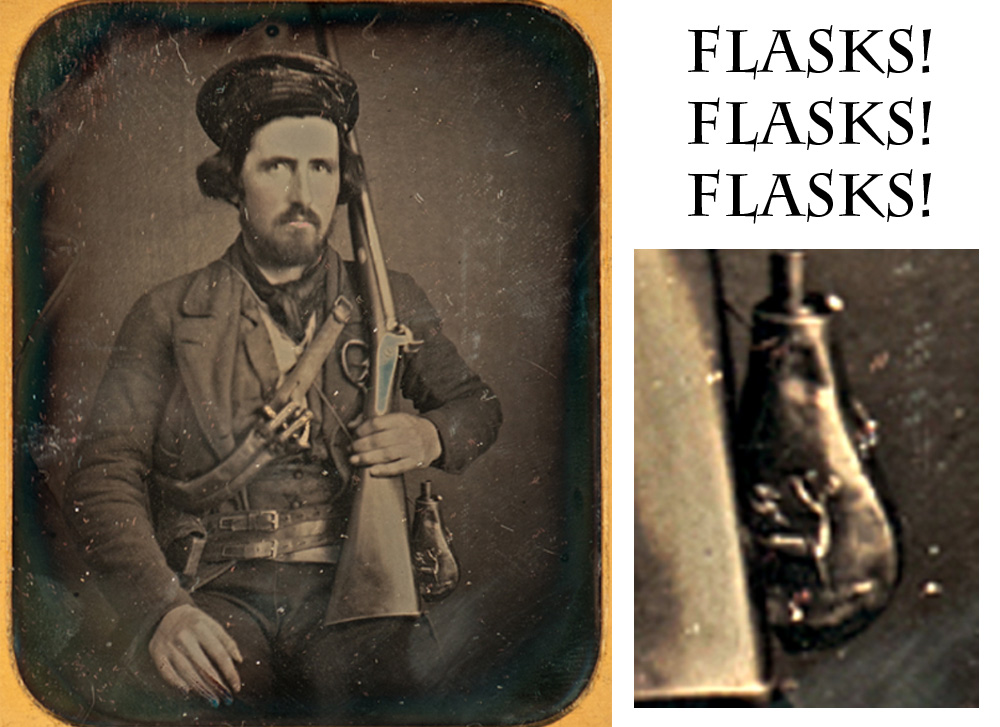
Wonderful Examples of the Die-Sinker’s Art!
Again this month I am pleased to offer the last elements of a fine old collection of mid 19th century powder flasks. You can learn more on the subject in Riling’s Powder Flask Book. In 19th century Europe hunting with firearms was largely the privilege of the nobility, whereas Americans all shot game to put food on the table. The Europeans went in for fancy carving and ivory inlays on their arms and flasks. We were satisfied with brass or German Silver inlays and felt fortunate when we could obtain a fine die-struck flask with a spring loaded measuring spout. Below are some examples of what we did allow ourselves to indulge in during the mid 19th century. I have included here a fine piece of 19th century Daguerrean photography showing an American hunter with his tools. For those of you who insist on mint condition, please note our subject’s hunting flask… those dents were there in 1850!
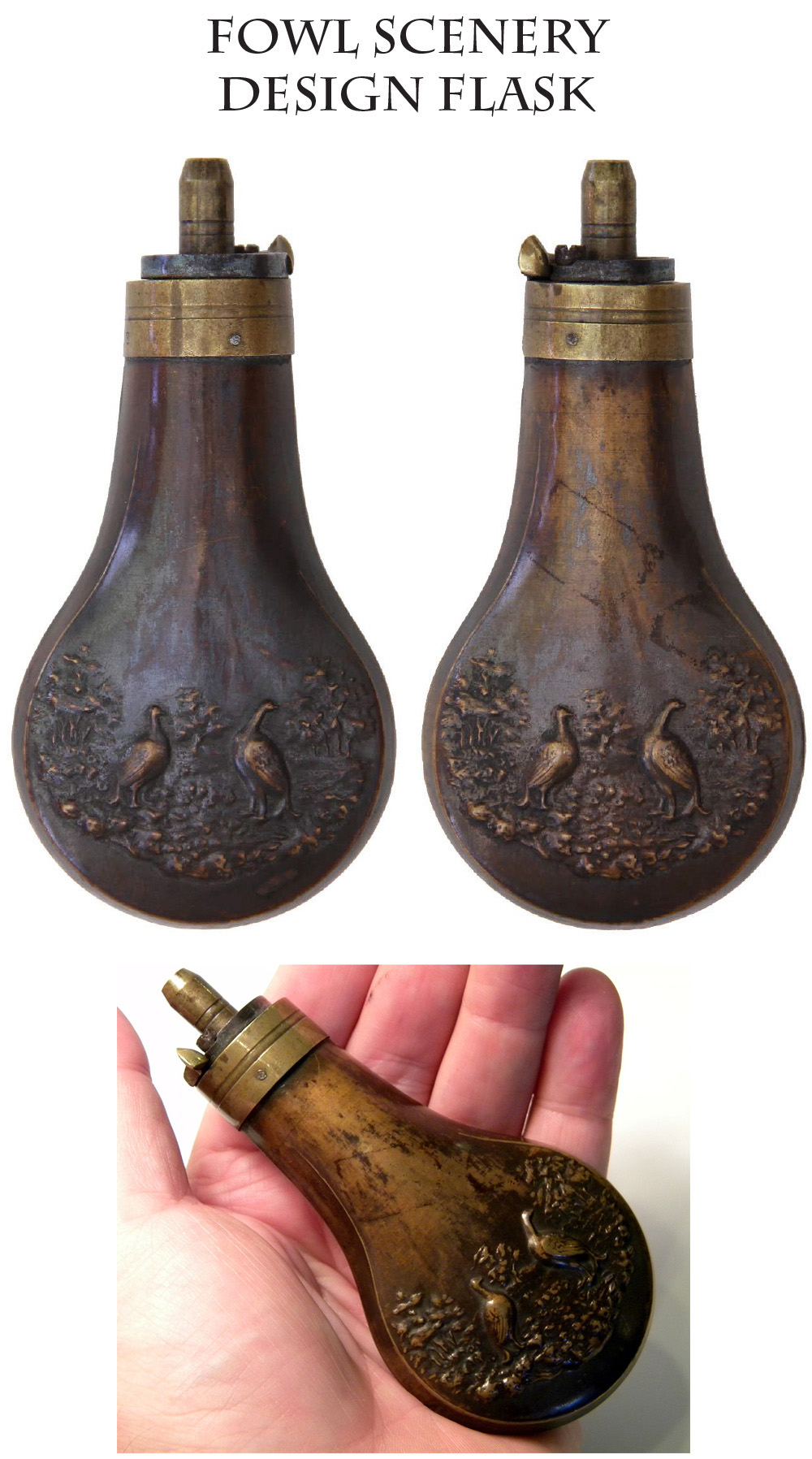
13-10-02 … Beautiful Copper Pistol or Pepperbox Flask with Partridge Decoration:
Smaller size flask for a cased pocket pistol or small pepperbox. Measures 4 5/8″ in total length including the spout. Nice scene of 2 partridges in nature pictured on each side. Overall about fine condition with a very attractive deep age patina.
… $150.00 SOLD
Click Here to E-mail Us!
Call us @ 419-842-1863
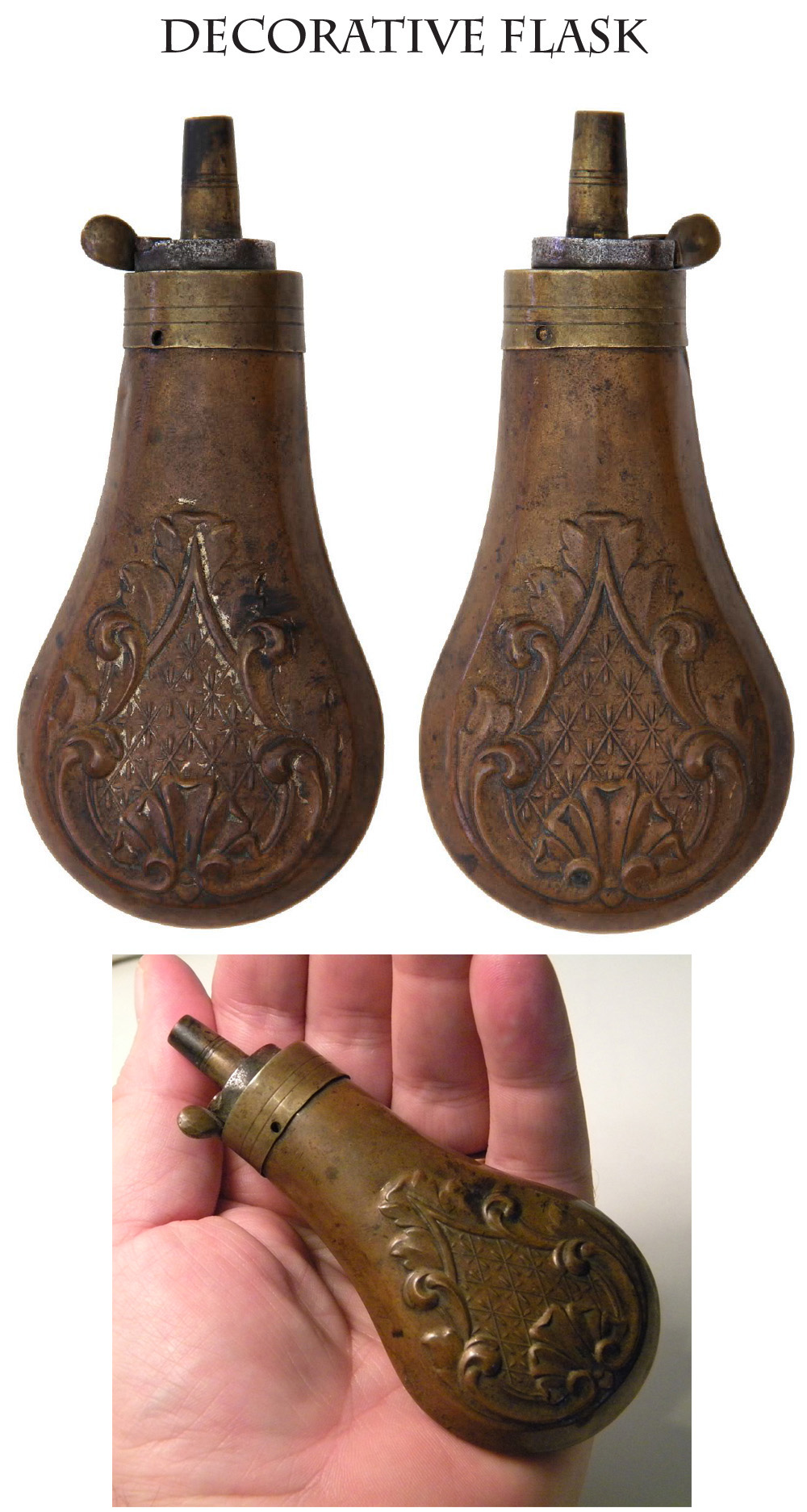
13-10-03 …
Another Beautiful Pistol Size Powder Flask …
Just short of 4 1/2 ” long including the spout… proper size for a .31 or .28 caliber pistol. In decent shape overall with only a small ding on one side. Lacks the two tiny screws that secure the cap and I don’t have any on hand. I will therefore price it cheap and you can add the fifty cents worth of screws and be the better-off for it
… $95.00 SOLD
Click Here to E-mail Us!
Call us @ 419-842-1863

13-10-04 … Beautiful 1820s Era Sykes Patent Copper Powder Flask
… About 7″ in total length, likely for use with a medium bore rifle. This octagonal design is unusual and is enhanced with multiple lines of engraved trim design on each side. It is marked on the spout Sykes Patent which proved an interesting research project. It occurs in 1824, that Mr. Sykes of London, a maker of quality powder flasks and shot pouches, sued a knock-off maker for manufacturing similar goods and marking them Sykes Patent for the purpose of defrauding buyers. (Imagine that!) I do not know if this is a Sykes- Sykes, or a knock-off Sykes, but then again I cant tell a real Gucci bag from a fake Gucci bag, and I dont care about that failing either. The quality is very good. There is a crack in a screw hole in the collar that secures the top to the body. (See picture.) This should be repaired. Aside from a few dings from normal use, it is in darn good shape for its age
… $125.00
Click Here to E-mail Us!
Call us @ 419-842-1863
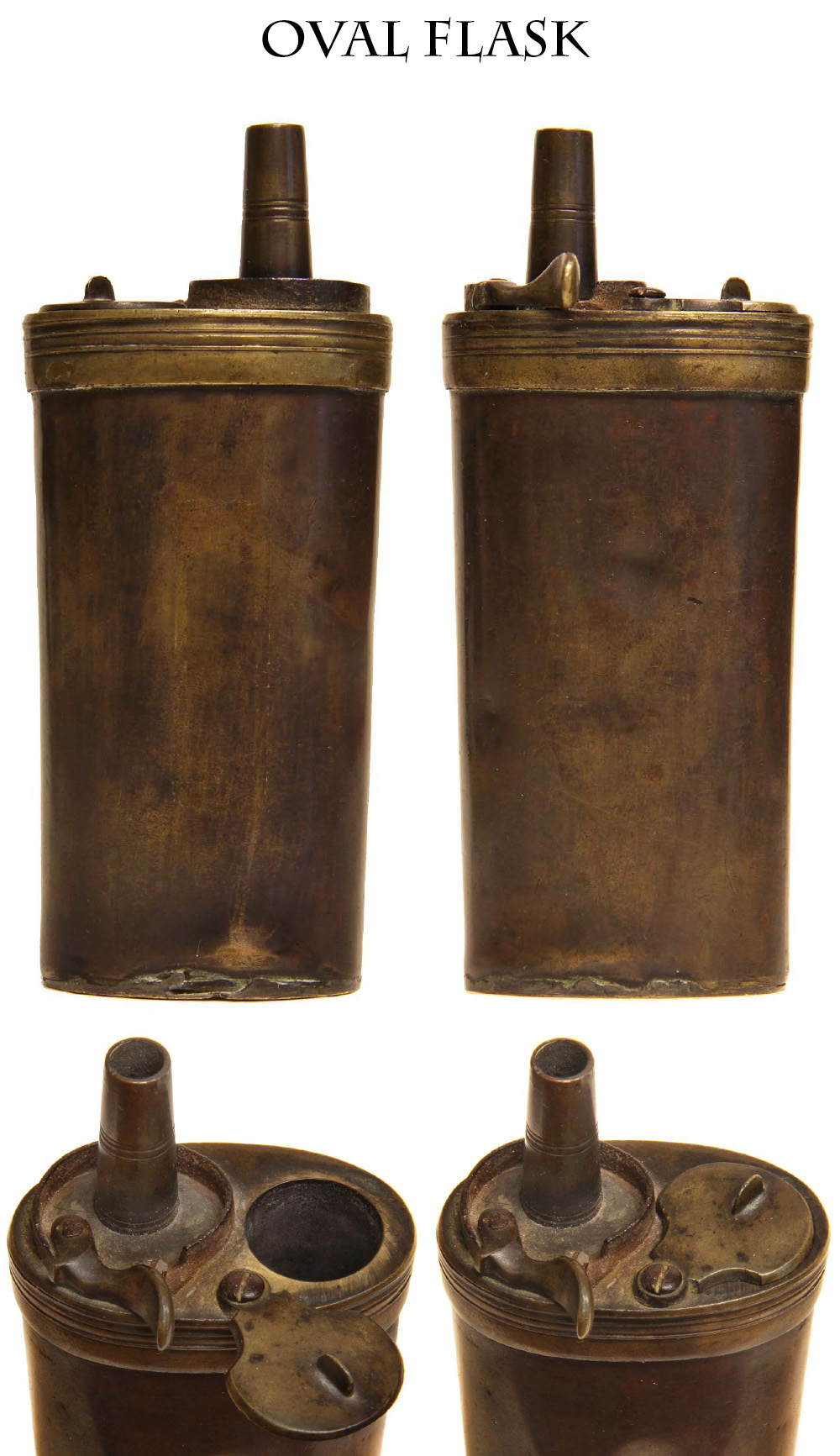
13-10-05 … Very Scarce Compartmental Pistol Powder Flask Ca. 1830-1845:
Rare oval, tapered design stands about 4 5/8 ” in total height, with a hinged-lid compartment next to the charger spout that carried pistol balls during its time of use. The design of this flask is most useful because the flat bottom design allows it to stand on its own. Bottom seam has an ancient solder repair. Copper body. Brass top and charger. Works perfectly. Many of these compartment style flasks have three openings… One for powder, One for caps, and One for bullets. This may well be an early flintlock example as it has only two compartments… Powder and Bullets…. No provision for caps. A great copper flask with much appeal. Would be a good companion piece to the first item on this list
… $350.00
Click Here to E-mail Us!
Call us @ 419-842-1863

13-10-06 … Damn Scarce Hard Rubber / Gutta Percha Powder Flask:
7 3/4 ” in total length, this flask has a beautiful smooth brown “hard rubber” or “thermoplastic” body that is excellent in all respects. This early “plastic” first came into regular use in 1851. It was scarce then and really scarce now. For the obvious reasons, these first “hard plastic” items do not survive. They were easily broken, and once broken could not be repaired. This flask is a size for a medium bore rifle or small bore fowler. It is larger than a Colt Army flask but smaller than a Peace Flask. The charger spout is signed “Am. Flask & Cap Co.” The brass collar has been hand engraved by its owner presumably with his initials (or so I would hope) “BM”. One heck of a nice early flask and quite a conversation piece being one of the first plastic items ever produced. Excellent condition
… $225.00
Click Here to E-mail Us!
Call us @ 419-842-1863

13-10-07 … Classic John Wilkes Booth Type Deringer:
A wonderful and complete silver mounted percussion deringer similar in style and design to the one Booth used to kill Lincoln. This is roughly 45 caliber and smooth bore. The stock is a straight grain dark walnut with hand checkered bag style grip. The trigger guard is engraved steel, the inlaid escutcheons are German silver. The lock, hammer, and barrel tang are all finely hand engraved. The gun is signed DERENGER on top of the barrel showing us that this is an 1840s 1850s knock off of the guns produced by Henry Deringer in Philadelphia. It is a real period deringer but it aint a Deringer – Deringer A very handsome and totally original and complete deringer which measures roughly seven inches overall length. I believe you will find this agreeably priced at
… $850.00 SOLD
Click Here to E-mail Us!
Call us @ 419-842-1863

13-10-08-A) Fine condition 6 ring bullseye canteen.
The standard mid-war bullseye pattern. It was at first thought that the concentric rings would afford more strength to the canteens than the standard smooth sides. Nope — so the army went back to the smooth side patterns again. Has all three strap brackets and the pewter spout firmly in place. Always a sought after accoutrement
… $195.00 SOLD
13-10-08-B) Regulation model 1858 Smooth Side Canteen:
The standard issue Civil War canteen that was in use throughout the war. VG condition with all three strap brackets and the the pewter spout firmly in place
… $150.00
13-10-08-C) … Spanish American War Canteen w/ Cover:
Standard Indian War canteen in fair to good condition. Cover is very worn and soiled. Both strap brackets are intact, as is the spout. Chain for stopper present but no stopper. Bargain basement deal
… $39.00
Click Here to E-mail Us!
Call us @ 419-842-1863
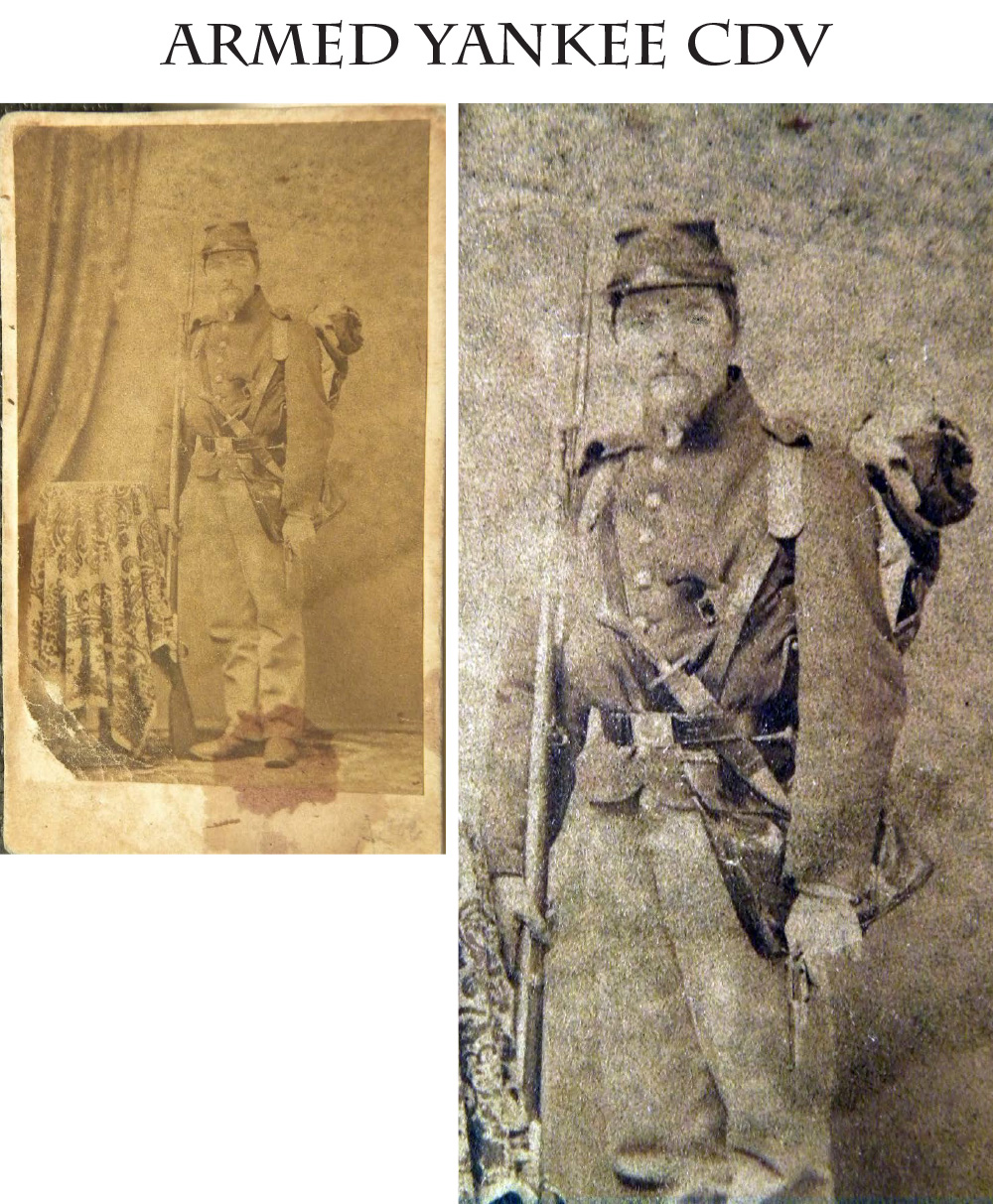
13-10-09 … CDV Decked Out Yankee Armed for Serious Killing:
This kind of pose is seldom found. Our brave Yankee private wears a state issue short jacket (likely NY) and state issue cap. His 1842 musket has the bayonet affixed. The grip of what appears to be an early 1850s Whitney pocket revolver peeks out from the leather knapsack strap on his left breast, a Colt Root revolver he holds in his left hand as his weapon of first option, and this serious Rebel Killer also has a monstrous stag handled Bowie Knife tucked right up front in his belt just in case. One musket, one bayonet, two revolvers, and one giant Bowie knife. If he can’t do the job done with those tools I reckon he might as well go back to the farm. Also of note is that he is posing with his knapsack and haversack, two pieces of equipment seldom seen in a CW photo. Condition is about fair to good as can be seen in the unaltered full view illustration. The image is somewhat faded, a bit yellowed, and slightly washed out … but still totally viewable with all the elements easily seen. I have shown a touched up enlarged version for the sake of detail. A mint CDV like this would command $2500 to $3500… I am able to sell this totally awesome image for
… $375.00 SOLD
Click Here to E-mail Us!
Call us @ 419-842-1863
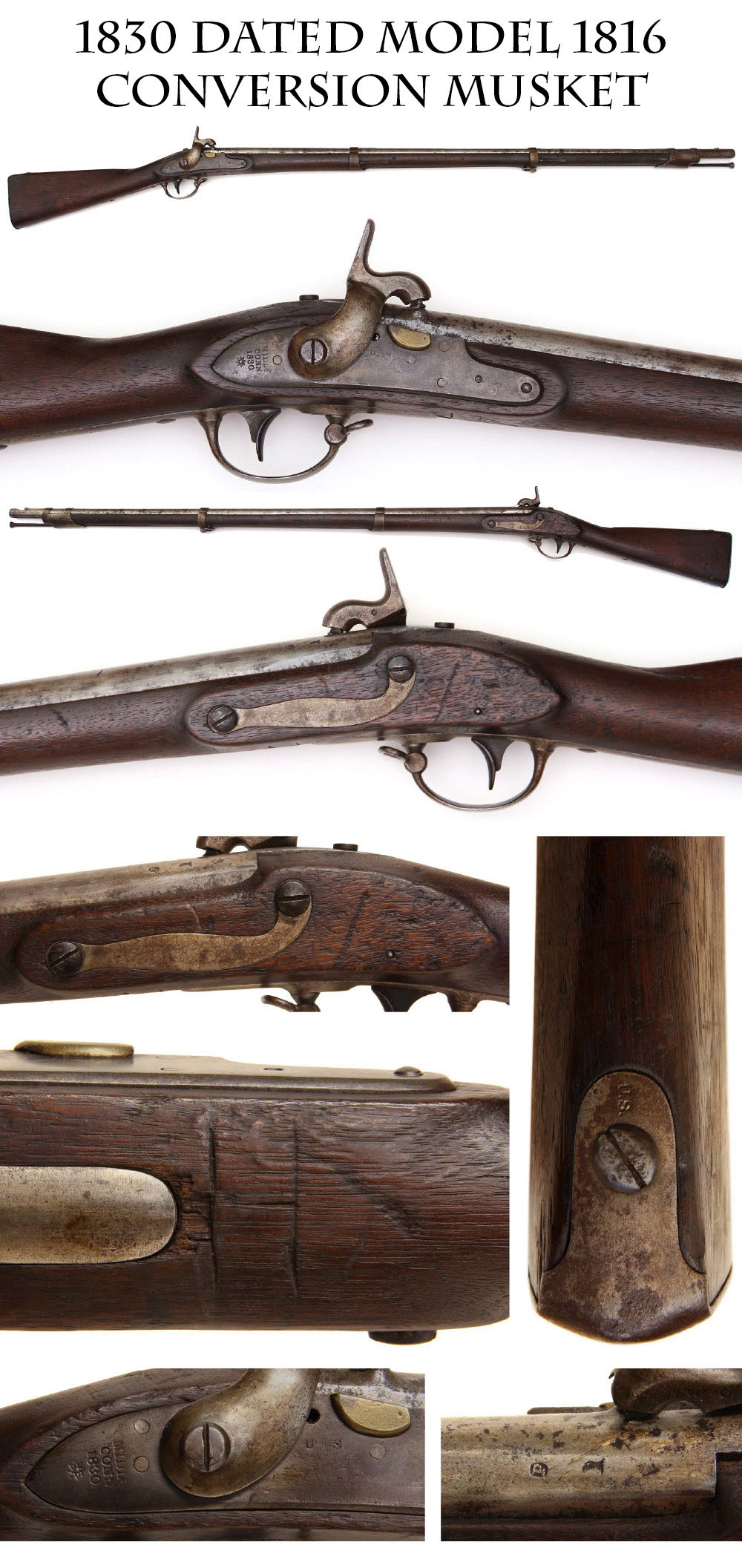
13-10-10 … Nathan Starr 1816 Pattern Musket dated 1830,
with an arsenal percussion conversion. Few American arms makers are better known than Starr, who had a wide variety of US contracts for muskets, pistols, sabers, and cutlasses over a long period. Here is a solid example of his 1816 Pattern Type 3 flintlock with the cone-in-barrel or Belgian style conversion favored by US arsenals. Starr made some 15,000 of these muskets between 1829 and 1840. This is one of the earliest versions, second year, and bears the 8-pointed star or floral motif at rear of the lock behind MIDDtn/ CONN/1830. Forward of the hammer is the standard small US over a sunburst and N. Starr. The lower portion of the sunburst and the Starr name are rubbed as is often the case when the arsenal ground down the brass flash pan and added a military percussion hammer. The US mark is sharp. Clear eagle head and sunken P proofmarks on the left barrel near breach. Good strong edges on wood around lock and a good butt stock and fore stock. Some wood dings opposite the lock, very minor chips to edge of triggerguard tang on underside and a carved letter H from a previous owner or soldier. Lock plate shows cloudy gray of faded case color, barrel is dull silver with rising brown areas, but smooth overall with just a couple of corrosion dimples near the nipple from firing. Correct swivels, ramrod, barrel bands and springs, mechanics good. After the percussion system was adopted by the U.S. government flintlock arms held by arsenals were divided into classes by age and condition and the newest and best condition guns were converted to the new system by several methods. The cone-in-barrel style was the one favored by the arsenals. These became the weapons issued to volunteers in the early years of the Civil War as the army expanded and new production could not keep up. This gun has surely seen some good history, a pre-Alamo and Seminole War musket that later found its way into the ranks of the north or south, in 1861. Very good to near fine condition. 100% original, 100% complete, and mechanically perfect. A very affordable musket from Americas early days
… $975.00
Click Here to E-mail Us!
Call us @ 419-842-1863

13-10-11 … Indian War Belt and Holster:
The belt is the standard 1872-1874 US regulation waist belt designed to accept the rectangular cast brass US buckle. The holster is a mystery to me. It came on this belt but I do not recognize it. It has a ferrous metal closing finial, and full military style closure flap. It is open ended (made with no plug in the bottom). It is solid and it is very stiff. I tried fitting a Colt Single Action in it and succeeded only in popping two inches of the ancient stitching along the sewn edge. SORRY ! I suppose when the holster was young it might have been able to carry a Single Action … but it was probably designed for some other shooting iron. Nice old gun belt rig priced fairly. All you need is a buckle and you are in business
… $195.00 SOLD
Click Here to E-mail Us!
Call us @ 419-842-1863

13-10-12 … Fine Condition &
Extremely Scarce Sharps Model 1852 Carbine – This is the early 1850s production Sharps in their standard 52 Caliber. It features the pellet priming system, and was their first model to have the slant-breech design. This is the pattern made from 1853-1855 by Robbins and Lawrence in Windsor, Vermont, for the Sharps Rifle Company in Hartford, total production was about 5,000 guns. This has the long sling ring slide bar that connects to the brass barrel band and the frame, just like on the subsequent 1853 John Brown pattern. The wood is about fine, with the slightest hint of handling wear and some expected light nicks and dings. Steel is overall plum patina, with rumors of silvery case on parts of the frame. The barrel is plum color with a touch with vivid firm markings on the barrel legend. Overall VG++ / near fine. A great early Sharps just as carried by the US Dragoons on the western frontier during the 1850s, and by both Union and Confederate cavalry in the Civil War. Perfect for display with US or CS cavalry effects, or early Indian fighter effects. One of the nicest I have owned. Sn# 5758
… $4600.00 SOLD
Click Here to E-mail Us!
Call us @ 419-842-1863
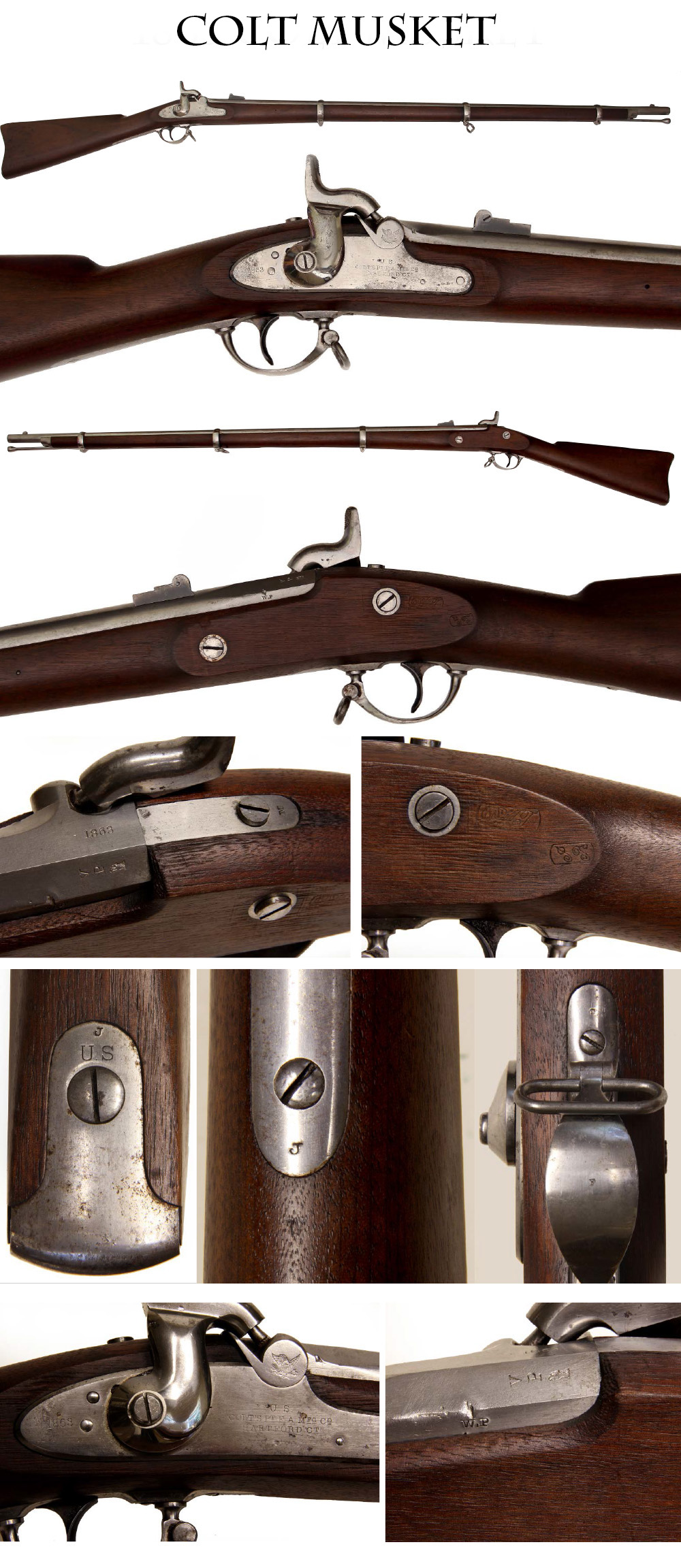
13-10-13 … Near Mint Colt Special Model 1861 Contract Rifle-Musket Dated 1863:
Colonel Colt was always thinking. Here we see some changes he made in the standard US 1861 Springfield pattern rifle musket. Colt and others adopted the changes from features on the British Enfields. Colt changed the contour of the hammer to an elegant S-curve, and did away with barrel band springs, changing the bands to a screw-fastened clamp style- Enfield style – and by 1863 the US government followed some of his leads when adopting the 1863 pattern rifle muskets. This is a near mint example with excellent wood, sharp edges, crisp markings and proofs, and vivid cartouches on the left flat that jump out at you across the room. 100% Correct swivels, rod, sights, etc. Mechanically excellent. Metal in the bright, as issued, rear sight showing traces of blue, as is correct. Mint bore. Colt markings, 1863 date and eagle on bolster are vivid. All the steel is factory bright. Lockplate has some very slight graying at edges. Very crisp V/P/eagle barrel proofs and matching 1863 barrel date. Sub-inspector and assembly letters on various parts. Small check in the metal at the left barrel flat above the “W.P” stamp, a smaller check on the side opposite near the bolster. The only minor wart on this musket is that a previous collector tried to knock off some surface rust on the edge of the lock and did so using a wire wheel without removing the lock from the gun. He did the same thing on the stock flat near one of the lock screws. Consequently, there are three small areas of wire-brush abrasions in the wood around the lock. Yeah, I know, You would have to be one hell of a lazy Billy-Bob to even think about such a move…. But what can we do… Spilt milk, and you have to look close to see it. Colt, Amoskeag and the company of Lamson, Goodnow and Yale (later just E. Lamson) were the only ones to produce this “Special Model 1861” pattern. They supplied about 150,000 of them to the government, Colt is the most famous of all the makers. A key weapon in a Civil War or US martial arms collection
… $3,850.00 SOLD
Click Here to E-mail Us!
Call us @ 419-842-1863

13-10-14 … Scarce Large Bore Ballard Carbine in the rare .56-.56 caliber
supplied by Merwin and Bray to Kentucky in 1864. The Ballard story is a complicated one. Anyone wishing to get the basic history should consult Flayderman’s Guide as a starting point. Five different companies produced the guns at different times and in different calibers. Merwin and Bray, New York firearms dealers, were awarded a US contract for a thousand large bore Ballard carbines and rifles, and sub-contracted the work to the firm of Dwight, Chapin and Co. That firm eventually went belly up and Merwin and Bray bought their completed guns and unassembled parts, and contracted then with the firm of Ball and Williams to complete the work. Guns by Merwin and Bray can be found with both Dwight, Chapin and with Ball and Williams markings. The exception is the group of 1,000 carbines in .56-.56 caliber (actually more like .52, but that is another story) that were marked only with Ballard Patent and Merwin and Bray Agents markings. This entire group was purchased by the state of Kentucky in April, 1864. Our gun is a really nice example of that scarce contract. Clear “Ballard’s Patent / Nov. 5, 1861” markings on right of receiver and “Merwin & Bray/ Agt’s N.Y.” over serial number “483” on the left, very legible, just a little light in the center of the stamp. Sights firmly in place, including the 250 and 500 yard graduated rear leaf sight. Both swivels in place- like many early war carbines this was intended to be carried on a more conventional style rifle sling rather than the wide and cumbersome brass mounted carbine sling. Very nice wood with good, even dark tone, and sharp edges. I see just one or two light rub marks. Nice smooth metal overall, mixed plum with darker smoky blue and a little gray here and there. A few expected handling dings on the receiver. Overall a very attractive carbine with homogenous patina on all the metal. Mechanically perfect. 100% original, 100% complete. A key weapon in a carbine collection and a very scarce one in this caliber and condition. Also a real nice piece of Kentucky history. Rates NRA Very Good +++ to near fine condition
… $2,650.00
Click Here to E-mail Us!
Call us @ 419-842-1863

13-10-15 … Pittsburg over-under Cap and Ball Double Set Trigger Rifle:
Very well made. Upper barrel is about 40 caliber rifled. Under barrel is about 20 gauge smooth bore, and heavy walled for use with shot or ball. 44 inches overall length. 28 inch barrels. Has lollipop flip-up rear sight. Both side slapper hammers function fine, as do the set triggers. Nice oval German silver patch box. Profusely marked. W K Strong on lock James Bown & Son Pittsburgh on barrel Enterprize on barrel … Here is what we know about the Bown family. From the book
“American Gunsmiths”
by Frank Sellers, James Bown (1823-? ). Pittsburgh, PA. 1848-1887. Operated as Bown & Tetley, operated as Bown & Son ( William H. Bown 1847). When Bown sold out to Brown & Hirth
they (? Does this “they” refer to Bown & Son or Brown & Hirth?)
used the name ” Enterprise Gun Works”….. Bown & Tetley, Pittsburgh PA 1848-1862, Large Manufacturer of Muzzle Loading Guns, as Enterprise Gun Works. Bown & Tetley. gun manufactory. 136 Wood St., Pittsburgh. James Bown was born in the England in 1823. He first went Canada with his parents in 1831 and then moved to New York state. Bown came to Pittsburgh at age 21 to work as a cutler with Cartwright Cutlery. Abram Tetley was also born in the England, in 1822. Bown & Tetley was established in 1848 as a cutlery and gradually grew into the gun business. Bown & Tetley were listed in all the period Pittsburgh directories. The Dir. of Pittsburgh and Allegheny City, 1850, calls the firm instrument maker. The Census of Industry of 1850 called the firm cutlers and showed they employed 7 hands with a $312 monthly payroll and made cutlery in the past 12 months valued at $7500. In the 1860 U.S. Census of Industry the firm was reported as having a $20,000 capital investment and a 14 horsepower steam engine. Over the previous 12 months it had bought $5800 in iron, wood and other raw materials; and had made 1800 rifles valued at $23,000. In May 1857 Bown and Tetley paid $2300 to Harvey Noble of Richland County, Ohio, for a lot in Pittsburgh’s Ninth Ward, which property had on it a building 40 by 90 feet, built of brick and containing a gun barrel manufactory. This was probably the J. and D. Little factory, begun by James and Daniel Little, which was bought out by Harvey Little and renamed Noble and Little, with James Little. James Bown and John Tetley bought out Abram Tetley on 6 February 1862, for $1000; and, in turn, in 1863 John Tetley sold out his interest to Bown for $1500. A period advertisement showed the diversity of products offered by the firm … Overall VG++ condition and very high quality. A great Civil War era double gun with much appeal
… $1,250.00 SOLD
Click Here to E-mail Us!
Call us @ 419-842-1863
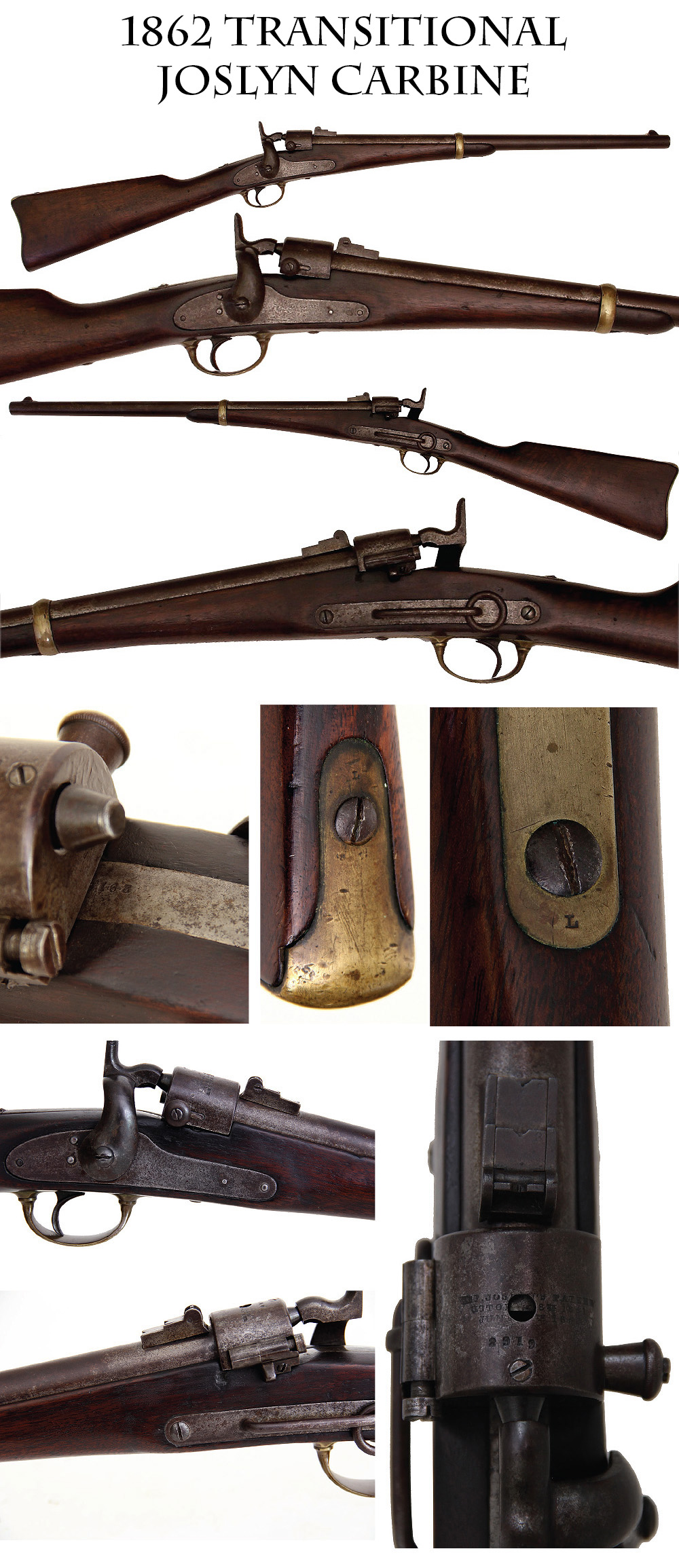
13-10-16 … Scarce Joslyn 1862 Transitional Model Carbine:
Joslyn’s were widely used throughout the war by the 19th NY Cavalry, as well as the 9th Pennsylvania, 2nd Wisconsin, 4th Indiana Cavalry and others. Several models were made and ours is one of the desirable military patterns designed to fire a the Spencer 56/56 caliber cartridge which is actually a .52 rimfire cartridge. Deliveries of the hinged breech models to the military started early in the war and lasted until 1865. The two major types of hinged breech Joslyns being the 1862 and the 1864 models. (There is a pre-war, so-called – “Monkey Tail Joslyn” that is extremely scarce.) This is the rare transitional pattern that Flayderman rates as “very scarce,” being produced only in the approximate serial range of #2400 to #3600. Ours is numbered 2919 and has all the expected features: Early 1862 pattern brass butt plate and barrel band, the 1864 style breech with the spring loaded knob to unlock the receiver, and a hooded firing pin,… while carrying the 1862 style patent information and serial number. The gun shows some use, but no abuse. Slight rounding to the edges of the wood from wartime handling but no splits or large dings. Sling bar and ring in place. Sights in place. Mechanically perfect. Steel shows typical faded-to-plum color becoming a little more mixed with grey toward the breech. Mixed speckled plum and silver on the receiver, smooth, no pitting. Nice patina to brass, minor dings on the butt plate, slight shrinkage gap on left of buttplate tang, hardly noticeable. A scarce pattern of a widely used cavalry arm
… $1,650.00 SOLD
Click Here to E-mail Us!
Call us @ 419-842-1863

13-10-17 … Rare & High Quality Cleveland, Ohio Kentucky Rifle by Henry Pierce:
Though unsigned, this rifle is the twin brother to one signed by Henry Pierce of eastern Ohio. Of peculiar note is the ingenious set trigger design which is peculiar to this maker. The set trigger is a single piece horse shoe … push forward to set the trigger, pull back to fire. Roughly 36 caliber, 30 inch octagon barrel. Overall length 46 inches. Fine tiger stripe maple stock. Fourteen German silver inlays and it has a wonderful and attractive long brass inlay which serves as a protective plate under the forearm, so the gun can be rested on a log without fear of damaging the stock. Has a long ramp rear sight with folding peep aperture at the extreme rear. Cool inset patch box incorporated into an elaborate brass inlay near the butt plate. Small catch missing from patch box. One of the more appealing Ohio rifles one can find … and quite a scarce maker to boot. Pierce (1811-1882) was born in Lucerne County, Pennsylvania and spent most of his working life in Liverpool, Medina County, and Grafton, Lorain County, Ohio. He appears in the 1850 Census as a gunsmith and in the 1860 Census as a Master Mechanic. The 1850 Manufacturers Census lists only one employee and, that year, shows he produced but twenty guns. See Hutslar, Ohio Gunsmiths and Allied Tradesmen, Volume III, pp. 141, 144, and 184. A great Ohio rifle and a great Ohio scarcity
… $1,950.00
Click Here to E-mail Us!
Call us @ 419-842-1863
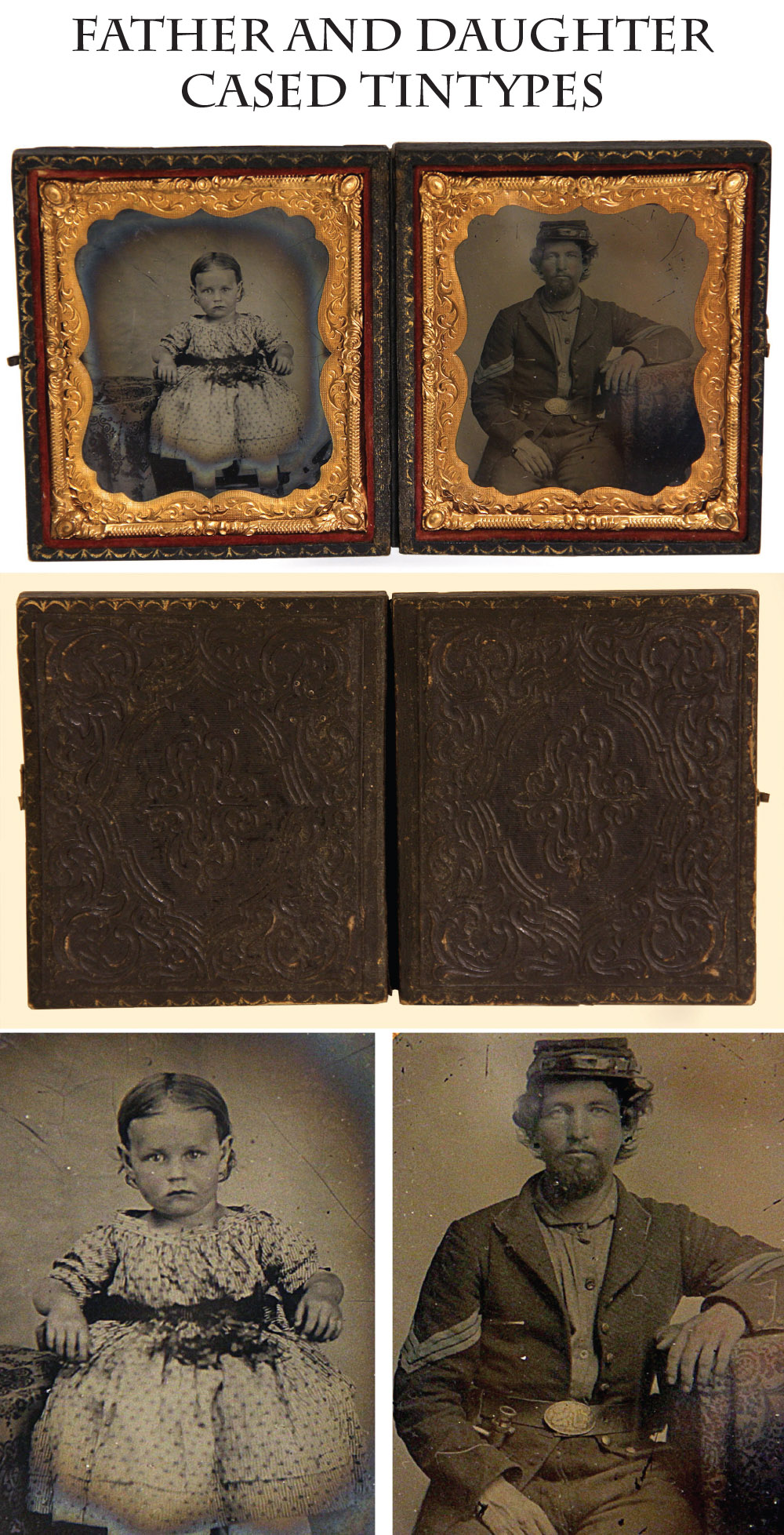
13-10-18 … Touching Pair of Sixth Plate tintypes of father and daughter.
Dad is a Yankee infantry sergeant with his belt and bayonet. Little girl is a cute little bug in her fancy duds. Nice double leatherette case. Very touching
… $265.00 SOLD
Click Here to E-mail Us!
Call us @ 419-842-1863
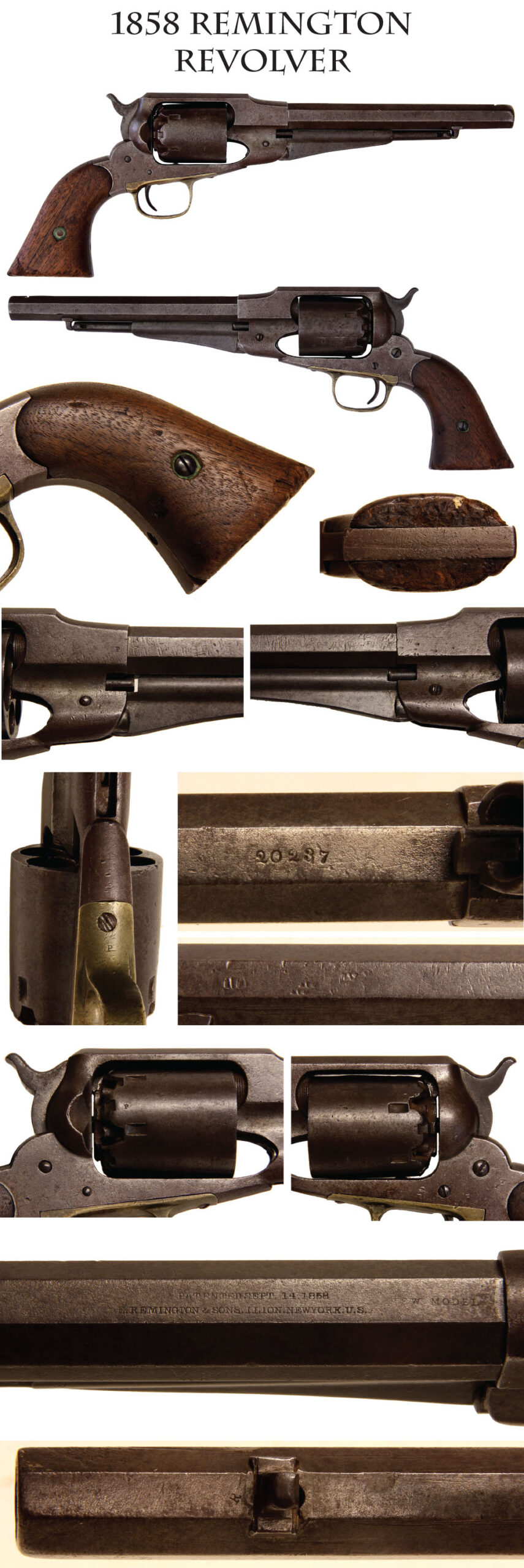
13-10-19 … Remington 44 Caliber New Model Army Revolver:
A very affordable example of the Union cavalryman’s weapon. Gun is solid and honest just needing a couple parts to complete it. The arbor (cylinder pin) needs to be replaced as the current one is a simple cold rolled steel rod. There is a crack in one of the chambers of the cylinder. The front sight is missing, and it needs a hand spring. Other than these small warts, the old war-horse is a tight and solid example of the Remington Army. It has an honest and uniform age patina, nice grips and good markings. The best part is the price… Where else can you get a decent Civil War cavalry revolver for
… $675.00 SOLD
Click Here to E-mail Us!
Call us @ 419-842-1863
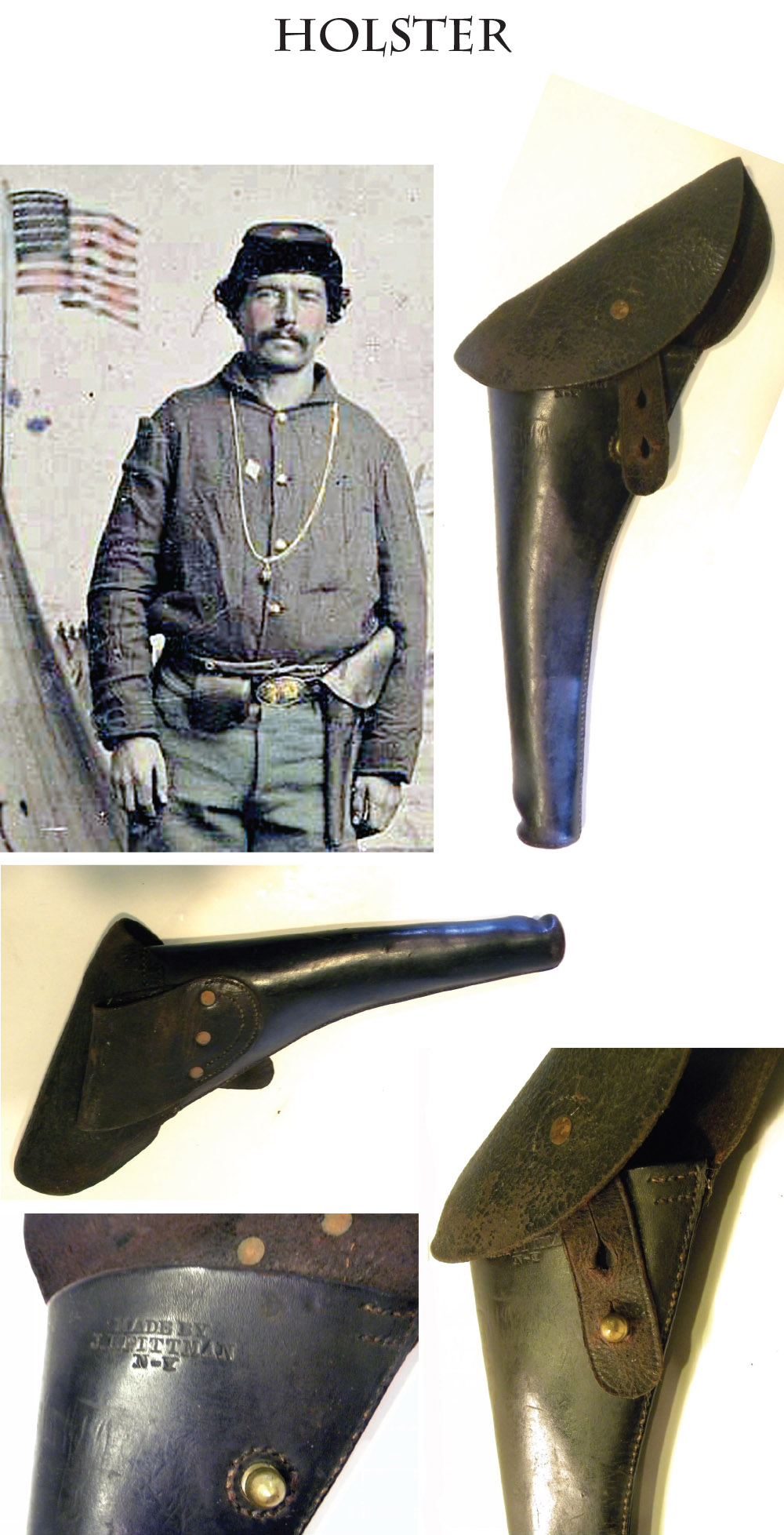
13-10-20 … Beautiful … SUPERB EXTRA FINE CIVIL WAR CAVALRY HOLSTER:
A regulation Civil War holster, proper left hand draw, full flap, military holster. This one rates a 9 on a scale of 1-10. Harness leather is truly superb, extra fine condition showing very little age. The flap has a bit of crazing in the finish but no flaking. The body is damn near mint. Latch tab and end plug are intact and excellent. Note that the tab has two holes for passing over the finial. Since this model fits a Navy and Army revolver (Remington and Colts and others too), we can surmise that the soldier who wore this one likely toted a navy revolver and tightened the latch tab to keep his sidearm from slipping away. Boldly maker marked Made By J.I. Pittman N-Y This is the best Ive found in a couple years. Well worth
… $775.00 SOLD
Click Here to E-mail Us!
Call us @ 419-842-1863
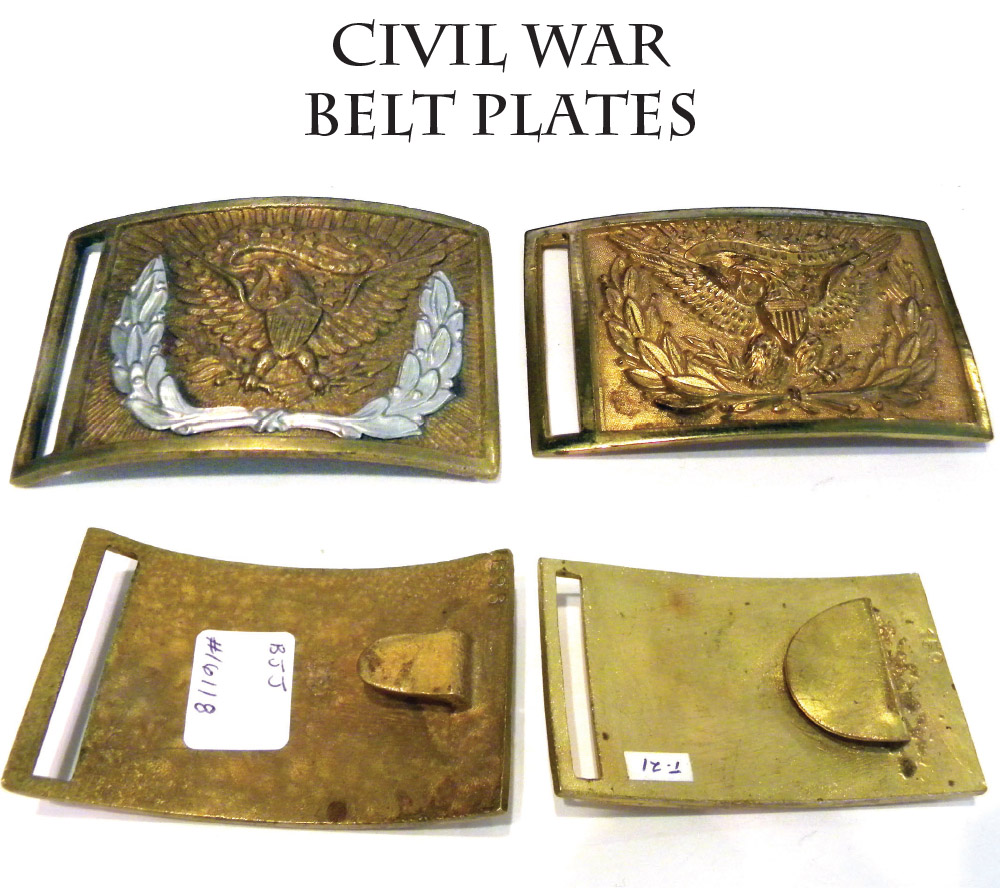
13-10-21 … (Left buckle) Fine condition Civil War Cavalry Sword Belt Plate –
This fine enlisted eagle buckle has a pretty reddish patina, and the applied German silver wreath. The buckle is in Fine++ condition with hardly any wear. It has the standard narrow tongue. The buckle is batch numbered 686. This is the buckle for the Union cavalryman’s saber belt. Once common in any antique shop, now quite scarce
… $335.00 SOLD
13-10-22 … (Right buckle) Extra Fine Regulation Civil War Officers Eagle Sword Belt Plate –
This is the sword belt plate worn by commissioned officers in the Union Army and also by more than a few Confederate officers. It is a mid war production plate with medium width tongue on the back. This is solid, handsome, and shows wear from actual war time service, while retaining virtually all of the heavy gold gilt finish. A fine honest plate priced well below the tourist town dealers
… $285.00 SOLD
Click Here to E-mail Us!
Call us @ 419-842-1863
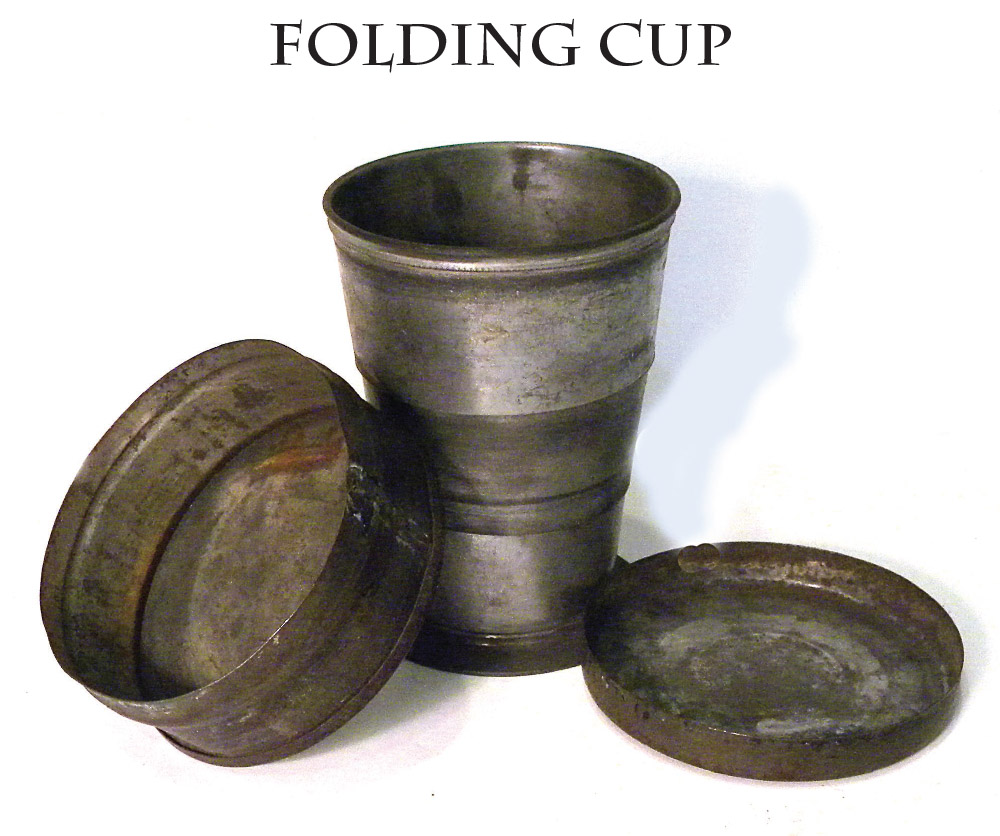
13-10-23 … PEWTER FOLDING – COLLAPSIBLE DRINKING CUP & CASE:
The quintessential traveling cup as seen in virtually every CW collection in the country. 5 inches tall when extended, and 1.5″ tall when collapsed. This one complete with the japanned tin carrying container which is roughly 3″ in diameter and 1.5″ high. Perfect condition, great to display with soldier personal items
… $135.00 SOLD
Click Here to E-mail Us!
Call us @ 419-842-1863
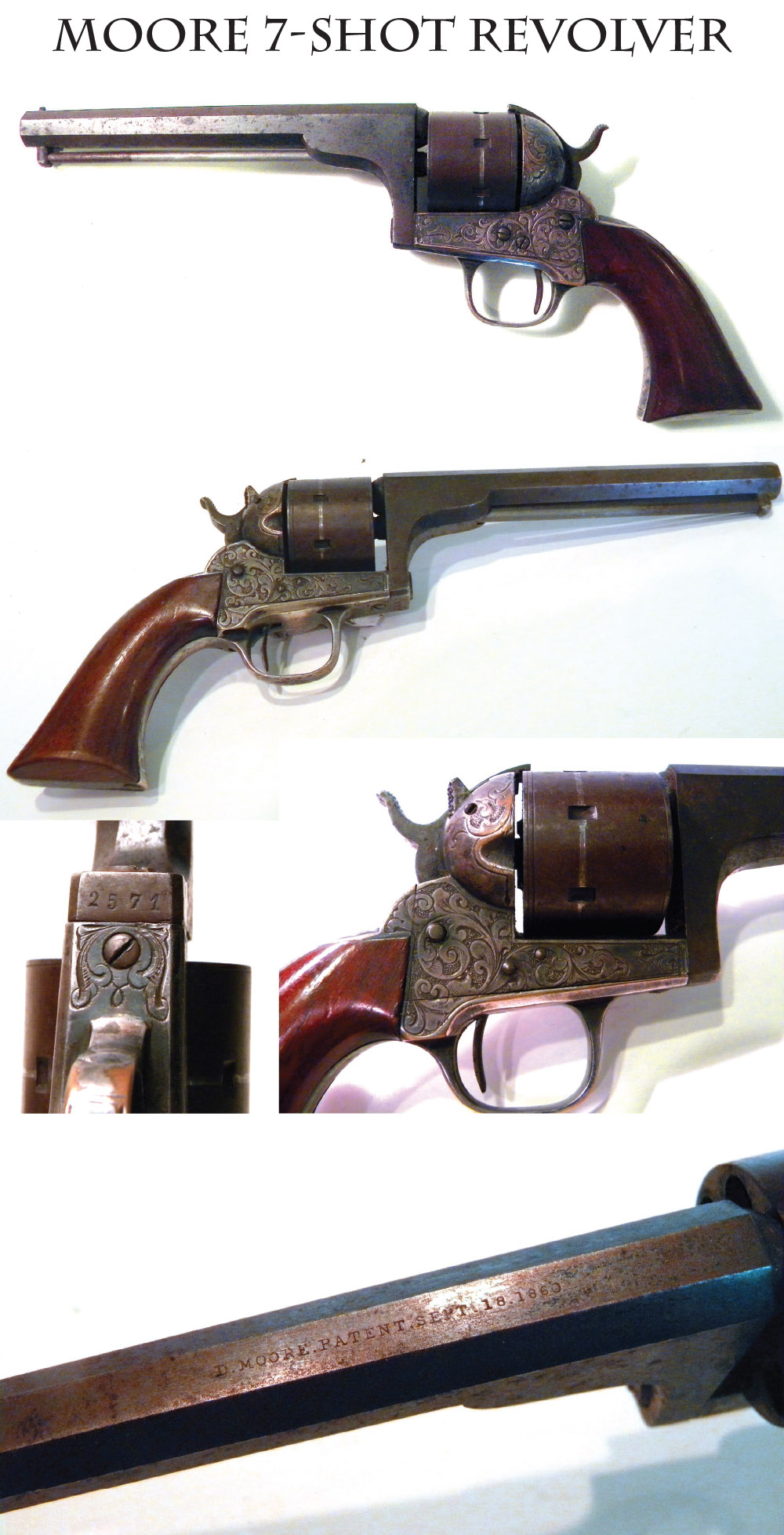
13-10-24 … Extra Fine Moore 7 Shooter Revolver –
This is the 7 shot Moore cartridge revolver with desirable 6 inch octagonal barrel. 32 rimfire caliber. These were made in the early 1860’s and I have owned numerous examples inscribed to Civil War officers. They were very popular throughout the war. By mid war manufacturing was halted due to the Rollin White patent infringement law suit won by Smith & Wesson against numerous firearm companies, including Moore. Manufacturing soon resumed with the guns then being made for, and sold, for or by, Smith & Wesson as part of the settlement. The silver plated brass frame is beautifully hand engraved with scrollwork and retains about 40% of the silver plate. The cylinder and barrel retain generous amounts of the original factory blue finish. The barrel is marked “D. MOORE. PATENT. SEPT, 18. 1860.” 100% original except for a proper replaced ejector rod, which is always the case with Moores as the ejectors are a simple rolled steel rod retained only by a tiny spring in the frame, and they fall out and are lost 90% of the time. 100% complete, and mechanically perfect. Serial number 2571. A very fine example
… $1,195.00 SOLD
Click Here to E-mail Us!
Call us @ 419-842-1863

13-10-25 … Showy and nicely identified pocket sized New Testament presented by the Maryland State Bible Society to George F. Titus, Co. H, 5th Mass. together with his eagle discharge paper.
Bible societies throughout the country presented Bibles to soldiers going off to war. In this case the society also printed up fancy labels that were pasted inside the front cover allowing the soldier to inscribe it for use in identifying him: The wording in this is … Should I die on the battle field or in Hospital, for the sake of humanity, acquaint.. and here he filled in the name Mrs. E. A. Titus, … residing at Charlestown, Mass. (No. 13 Polk St.) of the fact, and where my remains may be found. Not the most encouraging thing to be given a young patriot after signing up, but a practical item nonetheless in the era before government issued identification tags. Mrs. Titus, of course, was likely his mother. The discharge is dated November, 1864, at Readville, Mass., and shows he was discharged upon completion of his enlistment for 100 days. The document is filled out and signed by his Captain and the mustering officer. An ink stamp at top notes that he has been paid in full. Fold lines on the discharge, one minor hole at center. Bible shows wear and abrasions at cover edges and spine from actual carrying by the soldier, but is still solid and displays great when open to the presentation label.
The Fifth Massachusetts Volunteer Militia did a couple tours of duty. Their 1864 tour was for one hundred days and they were posted in Baltimore, where they were assigned to various forts. In the run-up to the 1864 elections they were also posted by company and detachment at various points in eastern Maryland. Titus was 18 years-old and plasterer by trade when he enlisted as private on July 14, 1864 in the regiment. He mustered into Co. H on July 20, and served until muster out on Nov. 16, 1864. He was a member of GAR Post 11 (Abraham Lincoln) in Charlestown after the war and died in 1917. A nice pair of identified display items
… $275.00 SOLD
Click Here to E-mail Us!
Call us @ 419-842-1863
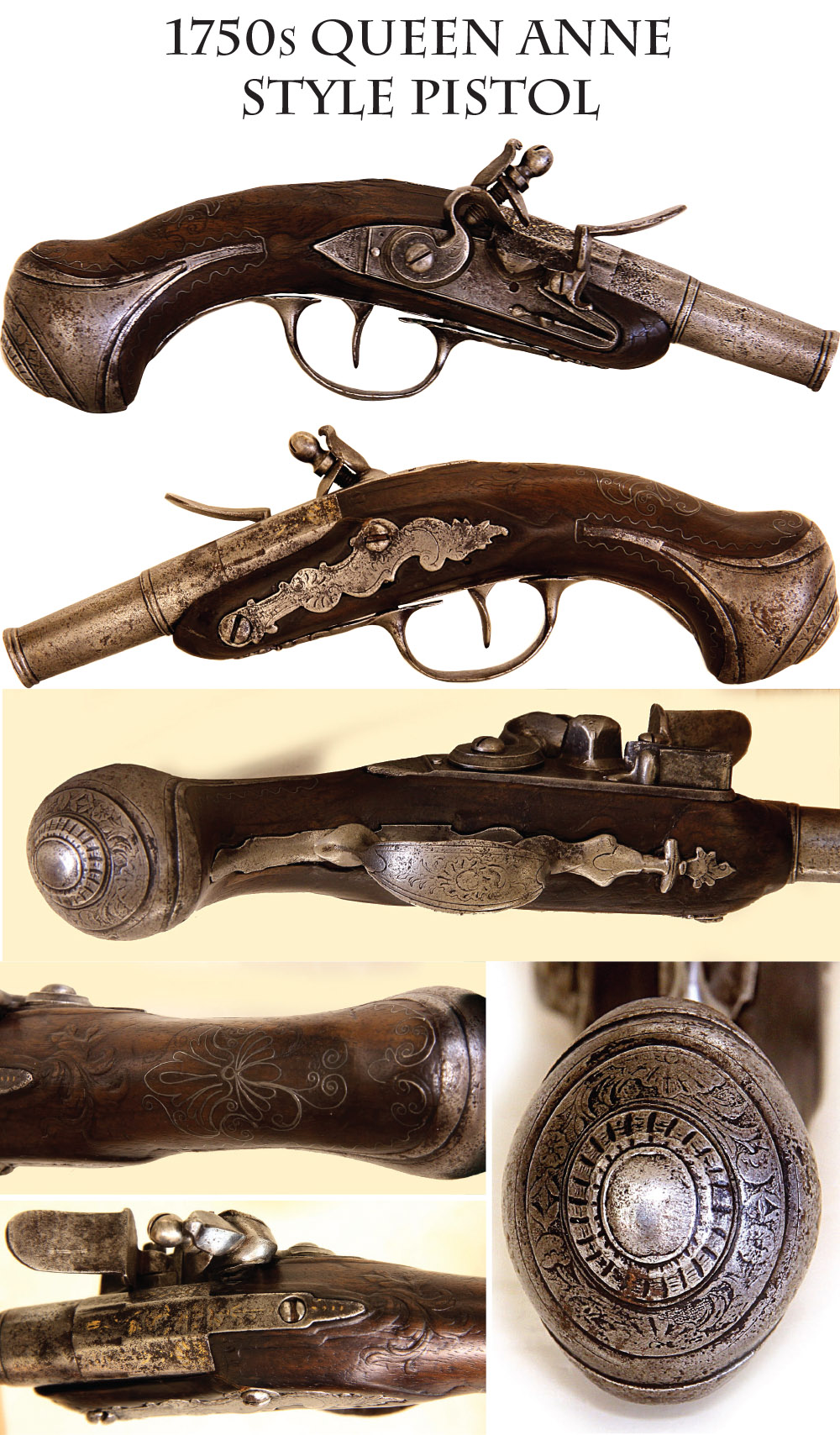
13-10-26 … 1750s Queen Anne Style Pocket Pistol:
Early steel mounted, silver wire inlayed flintlock pocket sized pistol with raised carving. Prominent butt cap engraved with geometric and floral designs, long tapering side straps deeply incised that give way to a plainer surface with more delicate lines toward the top. Bordered by a silver wire inlay squared at the top but wavy on either side of the strap on the way up, at the base forming a floral point at the lower center of the wrist just below a more elaborate wire inlayed floral spray midway up the grip. The motif is picked up in raised carving on the apron of the breechplug tang. Remnants of gold highlights remain on the top of the breech. Rounded edges to the raised carving around the apron showing it was definitely carried. One piece escutcheon sideplate with curved and floral edges, has lightly incised designs. Trigger guard is similarly engraved. The triggerguard tang is likely a period replacement as it bows out slightly forward on the underside and shows slight edge gaps on the lower portion of the inletting indicating an old repair. There is also evidence of wood repair in this area, done long ago. Light incised lines on triggerguard and lock plate. Floral design on flat hammer. Metal overall a faded silver gray with scattered dark areas and age spots, mostly near the breech. This style of pistol is sometimes termed the truncated form, where the stock extends beyond the lock plate and abruptly stops. Sometimes the barrels were screw-off with slots in the muzzle for insertion of a key wrench to allow for barrel removal and breech loading. On this specimen I see only rifling, which indicates the pistol was meant to be loaded from the muzzle. Collectors call these Queen Anne, though of course they were used into the reigns of the various Kings Georges. I think this one dates about 1750 or 1760, shows artistry in the inlay and carving, and has a great look for a colonial or flint pistol collection. Measures about 7″ from nose to butt.
A very fancy piece of antiquity priced quite affordably
… $1,350.00 SOLD
Click Here to E-mail Us!
Call us @ 419-842-1863
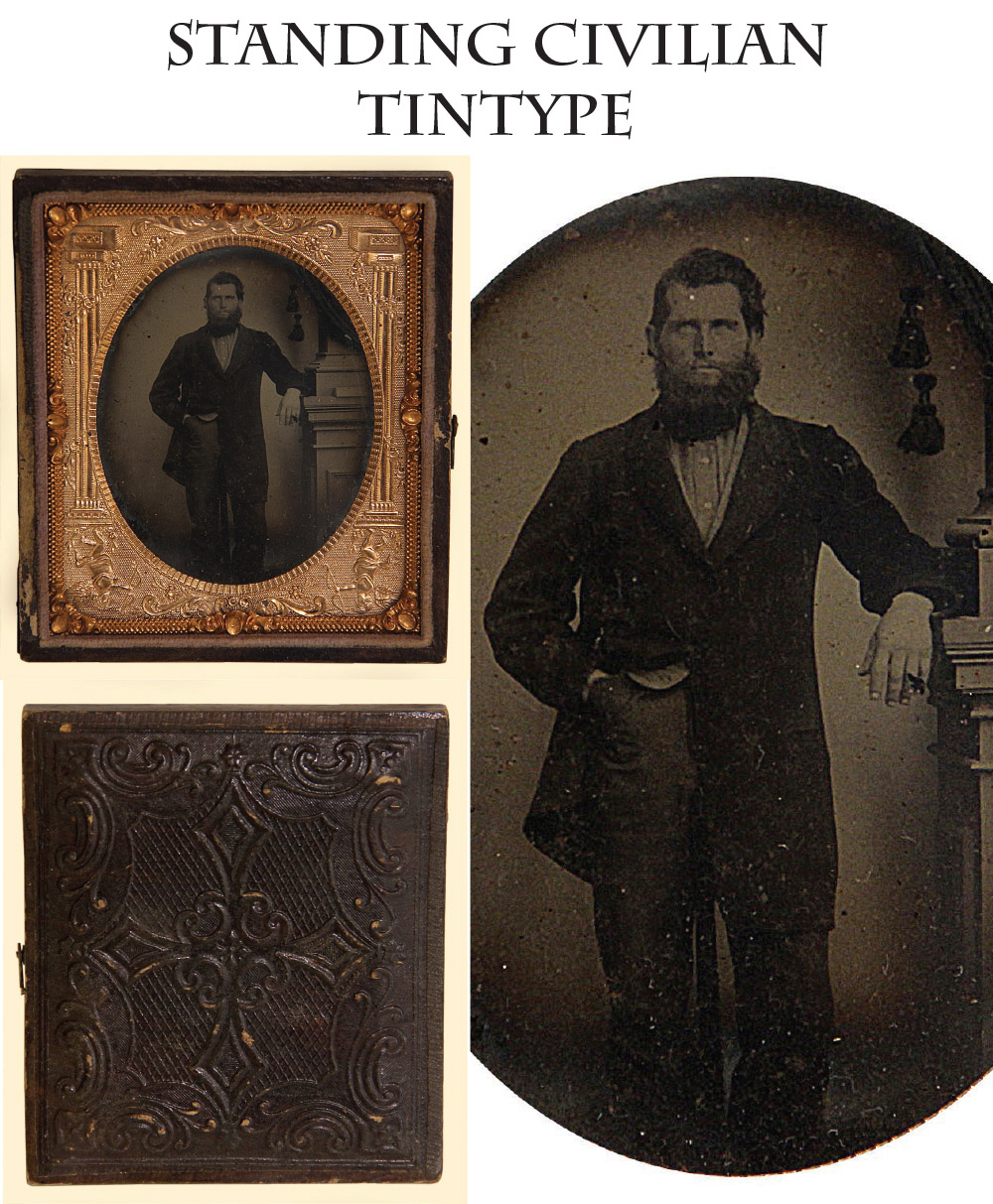
13-10-27 … Civilian Sixth Plate Tintype
of gentleman circa 1860. Nice period hard image
… $35.00
Click Here to E-mail Us!
Call us @ 419-842-1863
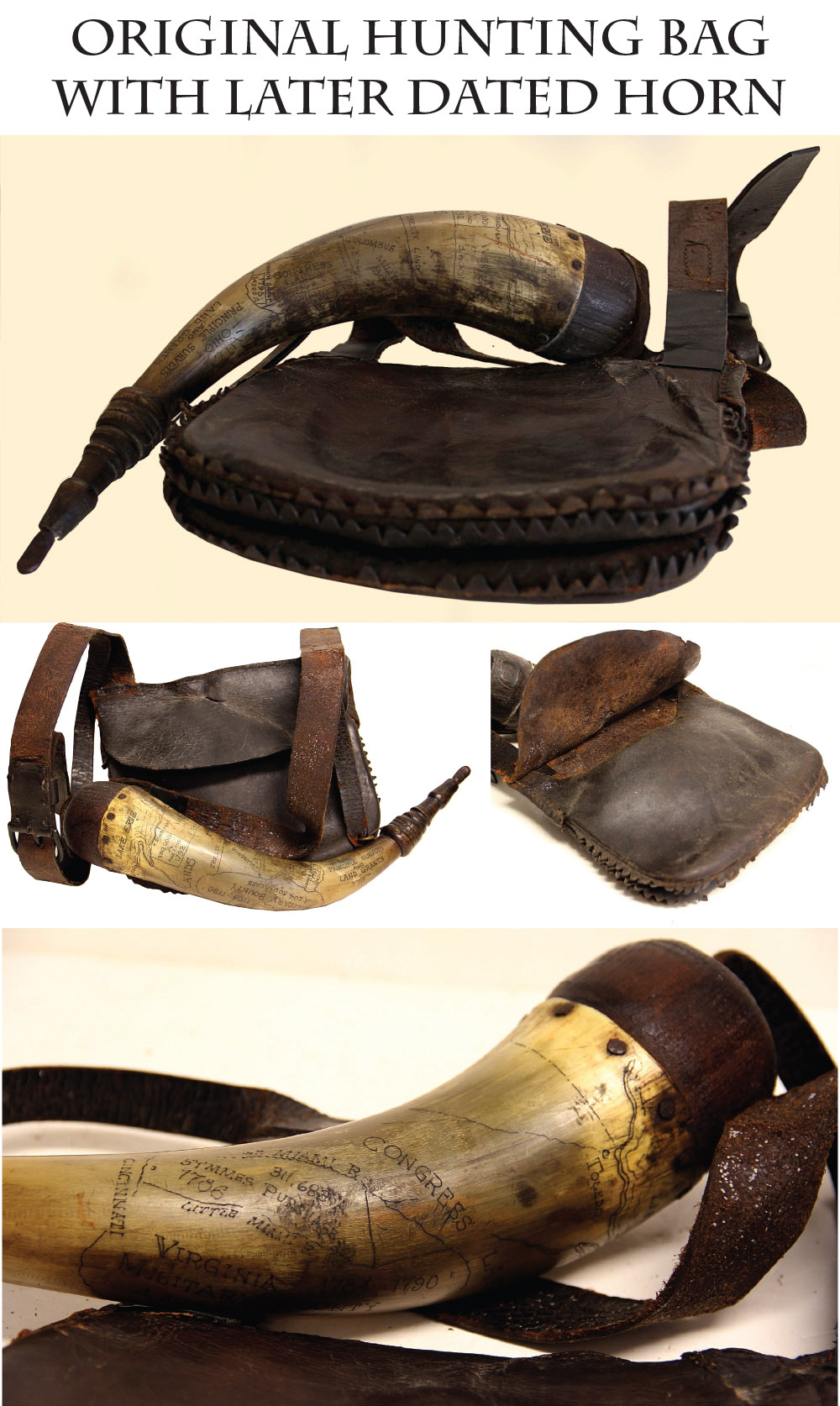
13-10-28 … Original 1860s Hunting Bag and Penna Style Powder Horn:
A great original 1860 era bag and its matching powder horn that a recent family member scrimshawed with maps of various land grants and treaties from Ohios early history. The horn appears to be a Pennsylvania made piece circa 1850-1860, same as the bag. The scrimshaw was likely done a century of more later … 1960s. Very nice condition early leather hunting bag for gun tools, rifle balls, etc. There are a couple small repairs to small rips in a couple straps. Original shoulder strap with adjusting buckle is in place, bellows bottom to the bag with decoratively cut fringed edges. Slight crease and very minor hole on the flap. Inner compartment and seams are solid and it displays very well. Powder horn is an original period horn with great architecture- I love the turnings on that spout- which someone in recent years has engraved with a map of the Ohio territory and land grants made after the Revolution. This was done not to deceive, but to record where the horn was found and the area of its likely use. I personally would have left the horn as is, but to each his own, and it certainly preserves the history with the horn. A nice set from the early frontier that would look great with that civilian hunting rifle
… $365.00 SOLD
Click Here to E-mail Us!
Call us @ 419-842-1863

13-10-29 … Photographs and Letter from the Great Sioux Uprising of 1862!
A truly rare and important collection of four carte-de-visite photographs and an 1862 manuscript letter regarding the uprising of several Eastern Sioux or Dakota tribes in Minnesota in the late summer of that year, and the murders of dozens of white settlers. The letter is on a single sheet of Civil War patriotic stationery dated September 5, 1862, and is written from La Crescent (Minnesota) by John S. Harris to his brother. Harris had settled in the town in 1856 and was a sort of Minnesota Johnny Appleseed, devoting himself to planting apple trees and developing varieties that could withstand the cold Minnesota winters. He was very successful and became known as the states Father of Orchardists, and the town now titles itself The Apple Capital of Minnesota. The areas earlier inhabitants, however, had been Dakota Indians, who by 1862 had been moved off their lands and onto reservations. That year annuities from the government were late, agents were not sympathetic and traders were refusing to sell food or goods on credit and starvation seemed not far off. In August trouble broke out and quickly expanded. Several bands of Sioux conspired to drive whites from the Minnesota River valley by bow & arrow, scalping knife and gun. It was a truly sanguinary crime that the warriors committed, the braves even bragged of killing young white children. Farms and settlements were attacked, complete families massacred. Battles were fought at Redwood Ferry and Birch Coulee, the town of New Ulm and even Fort Ridgely were attacked. Harris refers early on in his letter to not having heard from Frank since the battle, but this likely refers to a battle with Confederates that Frank was in, for he then goes on to give his brother news about the Indian uprising:
There is a great excitement up here about the Indians. they have murdered a great many familys (sic) out on the frontier & people here are very much alarmed. the women & children are being sent off by thousands. If I had any one to leave my family with I should go out & help fight them.
Minnesota militia and volunteer regiments were called into the field and by late September the fighting tapered off with the defeat of the Indians at Wood Lake. Many Indians surrendered, 303 were condemned to death by military tribunal. Most were pardoned by Lincoln, but 38 were eventually hanged together at Mankato.
All four of our cdvs are by Whitney of St. Paul, who had quite a business marketing photographs of the Sioux to the curious, some as ethnographic curiosities, others because of the historical importance.
1. MA-ZA-OO-NIE (The Little Bird Hunter.)
Pinhole at top of card, slight mark over the d in Bird. A very picturesque studio shot of a young boy in headdress and holding a tomahawk seated on a bearskin or buffalo rug. Buyers must have liked the subject because it was more quaint than threatening. Whitney sold a couple of different views of the boy. Of the four photos this is the only one with no known involvement in the uprising.
2. WA-KAN-O-ZHAN-ZHAN (Medicine Bottle)
Engaged in the Massacre of 1862. Later executed.
3. ANPETU-TOKECA (Other day.)
This is the Indian Hero of the affair Who rescued Sixty-two (white) persons from the Indian Massacre of 1862 in Minnesota. Also known as John Other Day, he was a former warrior turned farmer and Christian convert. He had been involved in the release of white captives from the Sioux in 1857, was a member of the Indian delegation to Washington in 1858 and gathered up some sixty white refugees at the Upper Sioux Agency during the 1862 uprising, guarded them and guided them to safety over the Minnesota River. The government gave him a $2,500 reward for his actions. He is a most historic figure.
4. SHA-KPE (Little Six.)
Sioux Chief, Engaged in Massacre of 1862, boasts of having killed thirteen Women and Children. He was executed for his crimes.
Our two warriors Little Six and Medicine Bottle were tribal leaders, related to other chiefs, and participants in the 1862 uprising. They escaped capture and fled to Canada late in 1862. They were then lured into a trap by British soldiers, captured and handed over to US troops in early 1864 who took them back to Minnesota, where they were both hanged in November, 1865, at Fort Snelling. It was reported in 1866 that instead of being buried, the bodies of both men were turned over to medical authorities for dissection and use in anatomy lectures, the body of Little Six being sent to a medical college in Philadelphia and that of Medicine Bottle to the Ramsey County Medical Society. Whitney photographed them both on June 17, 1864 and so labeled his cards. Both are shown seated against the same stonewall backdrop and it is felt that in the view of Little Six, the edge of the blanket worn by Medicine Bottle is visible at the left as they took turns being photographed.
All cards are in good condition with nice tones. Minor stains to top edge of the Medicine Bottle card, but not affecting the image. Other day has a tax stamp and cancellation dating it between the fall of 1864 and 1866. Slight turn to corner of albumen at upper right. Minor scratch upper left of Little Six image. Rounded corners for album insertion on the two leaders. One heck of an historic archive pertaining to real Wild West Indians and settlers
… $1,950.00 SOLD
Click Here to E-mail Us!
Call us @ 419-842-1863

13-10-30 … 52nd Massachusetts Soldier’s Diary, Stencil, Papers, and More:
A wonderful little archive fresh to the collector market. These are the effects of Joseph K. Hull, a 26 year old young man from Easthampton, Mass. First is his large size pocket diary with bold, readable, regular entries. It is executed mostly in ink with some pencil entries, it is complete from late September 1862 to early August 1863 which is the units entire term of service. Next is his large army stencil for marking clothing and personal items. Next is a long strip of linen marked three times with his stencil and then ink notated “Sept 1861 to August 1862”. Next are a couple morbid manuscript death poems … a sheet of paper with autographs from soldiers in different regiments he met in the service… and a stack of other papers and business cards and a small hunk of raw cotton … all jammed into the back of the diary. The 52nd saw action at Port Hudson, and Jackson Mississippi. On the 2d of December 1862 the regiment embarked on the steamer ILLINOIS for Louisiana. Touching at Ship Island and New Orleans, it reached Baton Rouge on the 17th where it was assigned to Kimball’s (2d) Brigade, Grover’s (4th) Division, l9th Corps. It participated in the demonstration against Port Hudson in cooperation with Farragut’s fleet in its attempt to pass the batteries. The regiment then penetrated to within a few hundred yards of the enemy’s works and held its advanced position for forty-eight hours, after which it began its return march, reaching its old camp at Baton Rouge, March 20, 1863. It later went to Thibodeau April 2. After the battle at Indian Ridge, in which the 52d did not participate the 52d joined in the pursuit to New Iberia. It was later moved to Springfield Landing just above Baton Rouge on May 30th, and then the regiment marched to join its brigade before Port Hudson. It participated in the assault of June 14, losing three men killed and seven wounded, Captain Bliss mortally.
On the 20th, while guarding a train of wagons near Jackson’s Cross Roads, it was attacked by the enemy. The enemy was repulsed, but many of the wagons were lost through the stampeding of the mules. Returning that night to the front at Port Hudson, the regiment remained there until the surrender of that place, July 9. The regiment was then sent home and mustered out of service August 14th 1863. Here are a few excerpts from the diary … “ … December 4th nice on deck today saw the porpoise jump out of the water … December 15th at anchor near the city … sailed up the Mississippi Wednesday December 17th arrived at Baton Rouge about half past 8 a.m. the iron clad gun boat opened fire on the city and one other gun boat. A few shots were fired and then flags were waved and our troops immediately landed our regiment about 1 p.m. The stars and Stripes were raised immediately. … June 14th preserve me oh God for in thee do I put my trust. It is warm and pleasant today … had a fight at Port Hudson today the 4th Wis. and 8th NH suffered severely. Daniel Wyman company K was killed today up to Port Hudson… Sgt. Bennett wounded, orderly Williston is in command of our company. … June 15th a few wounded came down the river also a few rebel prisoners … July 2nd Eben Anderson of company K died … 14 soldiers were buried today … the rebels made a dash on the Springfield landing and destroyed provisions, took prisoners and shot some negros. Some rebel prisoners went to N.O. this eve on the boat Sally Robinson.” A wonderful little group of personal items from the war in the deep south. Displays like a million dollars and priced at only
… $1,250.00 SOLD
Click Here to E-mail Us!
Call us @ 419-842-1863

13-10-31 … 2nd Illinois Cavalry Saber, Cartridge Box, and CDV Photo:
A wonderful lot of material in excellent condition. Set starts with a fine condition M1860 light cavalry saber made and marked by Ames and dated 1864. Very solid saber with super wrap. Next is a pre-war or early war western pattern militia cartridge box of a design I have owned several times including one specimen that was firmly attributed to a Missouri Confederate. These boxes all have brass buttons secured to the back for attaching a cloth shoulder strap. All of them have a crude tarred finish on the outer flap. All that I have owned have been connected to western theater troops US and CS. Last item is a SPECTACULAR outdoor CDV photo showing the troopers in camp of the 2nd Illinois Cavalry with a central group of troopers playing cards on the ground. The subject matter is truly spectacular. Inscribed on the reverse of the card is a family note I think this is a picture of my Grandpa Wm Ulrichs cavalry company during the Civil War. Ulrich served in the 2nd Illinois Cavalry in 1864 and 1865. He saw action in Louisiana at Sabine Cross roads, Alexandria, Yellow Bayou, and Fort Blakely. Ulrich served from Feb. 1864 until he was mustered out in Texas in late fall of 1865. I do not know if the cartridge box is one he carried or one he captured from a Rebel. I would be inclined to think the latter since US cavalry troops would certainly have access to regulation US gear by 1864. Super group of items. The camp photo is about as appealing as any Ive seen recently
… aiej … SOLD
Click Here to E-mail Us!
Call us @ 419-842-1863

13-10-32 … Percussion Conversion of US Martial 1836 Pistol:
About VG condition signed A Waters millbury 1837. Complete except for a main spring and hammer screw as far as I can tell. Steel is all gun-metal grey with light pitting. Retains the original rammer and capture swivel. Wood shows handling and abrasions. Both cartouches are vivid. Hammer is somewhat crude which opens the possibility that it may be a Confederate conversion. I found it cheap, so I’ll sell it cheap
… $535.00 SOLD
Click Here to E-mail Us!
Call us @ 419-842-1863

13-10-33 Double Barrel Percussion Pistol.
Classic last ditch self defense weapon. Double 45 caliber octagon barrels measure 3.25 inches in length. Overall length about eight inches. Nipples are battered and right hammer spur is chipped off. Otherwise fine. Mechanically functional but difficult to cock the right hammer due to the short spur. Where else can you purchase an 1860 pistol for
… $165.00 SOLD
Click Here to E-mail Us!
Call us @ 419-842-1863
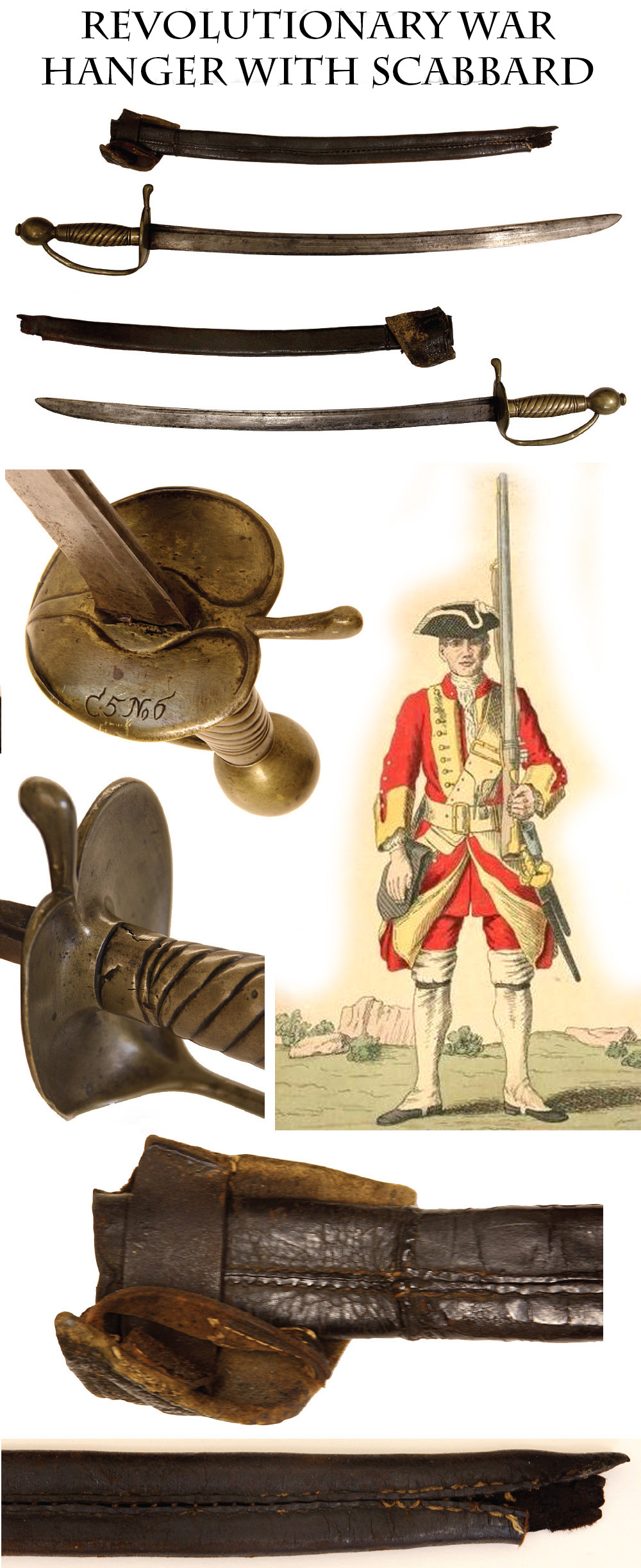
13-10-34 … The Real Deal – Revolutionary War Infantry Hanger WITH SCABBARD!:
This sword measures 29 inches overall and has a 22.75 inch blade. These all brass hilted short swords were designed as an infantry sidearm in England and worn with the bayonet from 1740-1780. Ours is virtually identical to the British version, but has the ultra desirable large globular pommel, which marks it clearly as being made in the German states, many of whom of course supplied arms and troops to the British through the period, such as the famous Hessian and Brunswick contingents that served here during the Revolutionary War. Our hanger bears the company and soldier rack numbers, C 5 No 6 for the sixth man of the fifth company. The most important element here is that we still have the original leather scabbard, which is almost unheard of – and which is far rarer than the sword itself. Of dark, blackish-brown leather, the scabbard is 90% intact. It just lacks the tip, which was usually a sewn-in simple tip. The top frog is firmly in place. The blade has a single back fuller, slightly rounded tip, no appreciable edge damage, and a uniform, bright gray color mixed with some darker areas throughout. Brass guard has a very attractive delicate age patina. This is a scarce colonial era piece and can be considered RARE with the leather scabbard. It is fully appropriate for the period of the Seven Years War up through the American Revolution. I look at this and think of some very disappointed German troops at Trenton, Bennington, and Saratoga. Heres your shot at a real Rev War weapon at a realistic price
… $1,450.00 SOLD
Click Here to E-mail Us!
Call us @ 419-842-1863
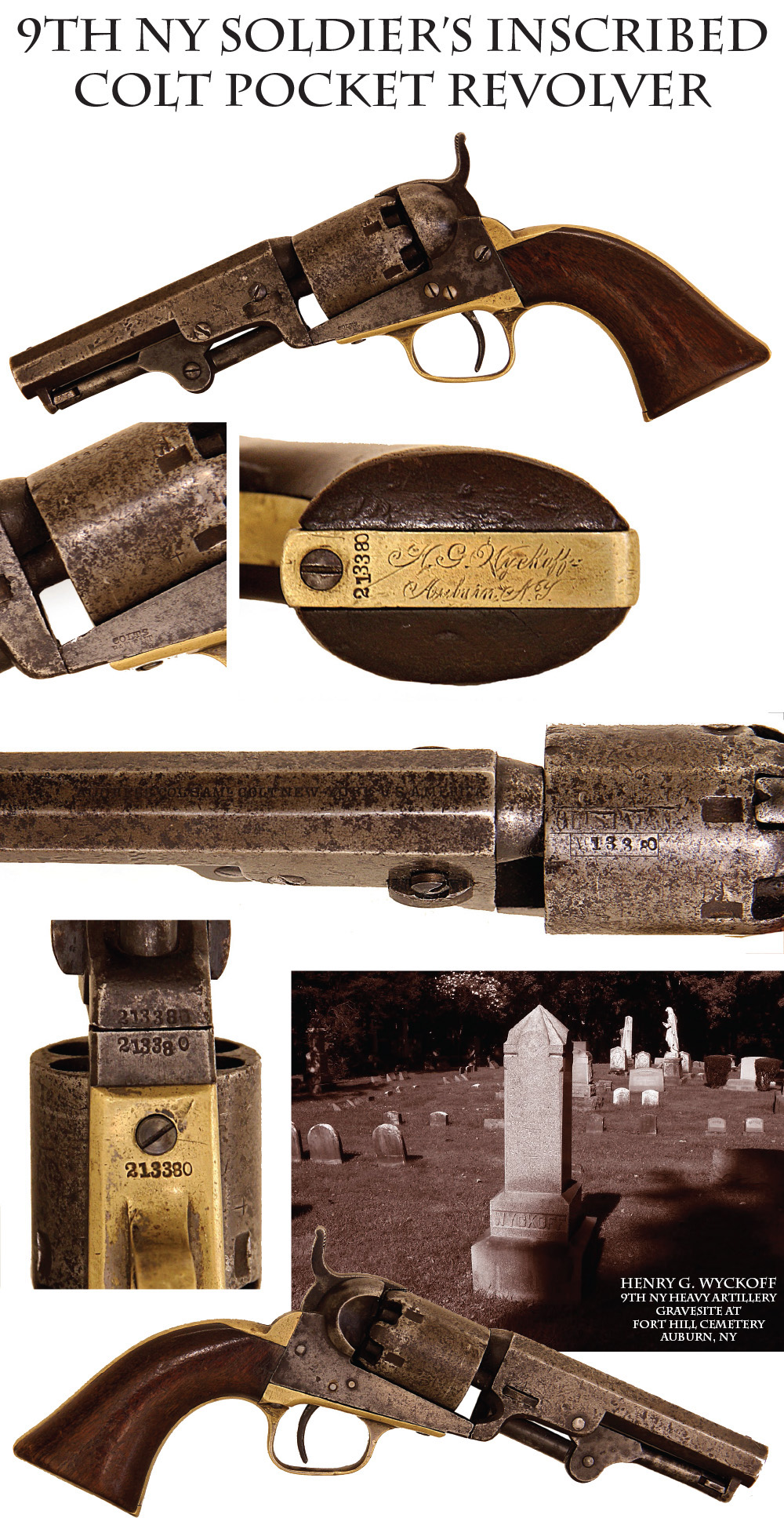
13-10-35 … Inscribed 9th NY Heavy Artillery Soldier’s Colt Pocket Revolver …
This pocket revolver was owned by Henry G. Wyckoff who enlisted in the NY 9th New York Heavy Artillery in August of 1862 and served through April 1864, at which time he transferred into the Veteran Reserve Corps. He and the rest of his company spent the early years of the war stationed in Washington D.C. and were responsible for the defense of the city. By 1864 Grant sent the heavy artillery boys to the front as infantry. Wyckoff lived until 1901 and was survived by his widow. The pistol has all matching early war serial numbers 213,380 and is 100% original & complete and is mechanically perfect. The walnut grip is in very good condition with just some light handling wear. The frame, cylinder, and barrel all have a speckled grey steel patina. The brass backstrap has an attractive patina, and the engraving on the butt is executed in fine Spenserian script carrying Wyckoff’s name and home town. The 9th NYHA left the State September 12, 1862, and served as infantry and heavy artillery in the defenses of Washington, D. C., north of the Potomac, from September, 1862; in the 2d, and later 3d, Brigade, Haskins’ Division, 22d Corps, from February, 1863; the 1st and 3d Battalions in the 2d Brigade, 3d Division; the 2d Battalion in the Artillery Brigade, 6th Corps, Army of the Potomac, from May 25 and 31, 1864. This is a nice Colt with a solid inscription and history
… $2450.00
Click Here to E-mail Us!
Call us @ 419-842-1863

13-10-37 … Union Army Cavalry Holster.
A solid example with good finish on the leather. Fits Colt or Remington Army and Navy revolvers. This one lost its latch tab during its period of use and the soldier simply put a button hole in the flap for the brass finial to pass through. A good solid Civil War holster
… $375.00 SOLD
Layaways are Welcome
Need to split your order into multiple payments? No problem! A simple 20% earnest money deposit will hold your item for you.-acf
You can then pay it off in easy installments that fit your budget.
Read Terms Here
Items to Sell? Contact Us
I am always interested in buying ANYTHING from the American Civil War… Guns, Swords, Civil War Muskets, Knives, Uniforms, Flags, Medals, Badges, Diaries, Letters, Autographs, Buttons, photographs, tintypes, daguerreotypes, Insignia, Camp Items, Battlefield Relics, canteens, Drums, Etc… Call 419-842-1863 and ask for Dave Taylor.

